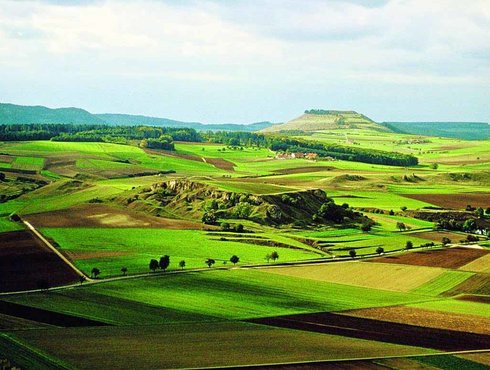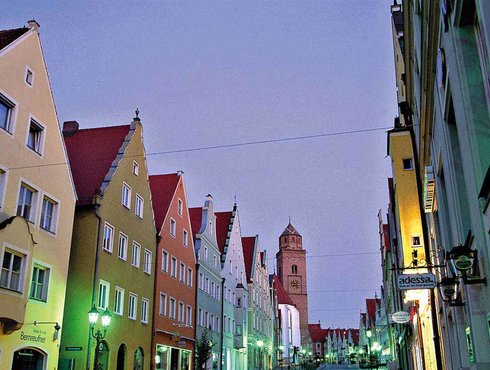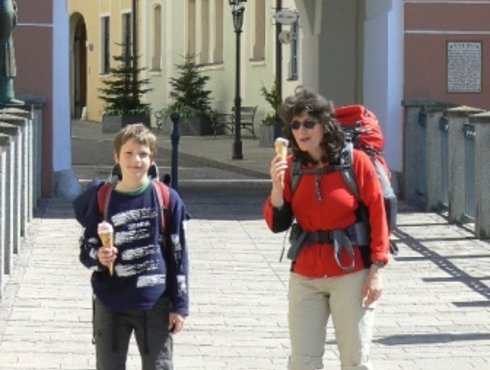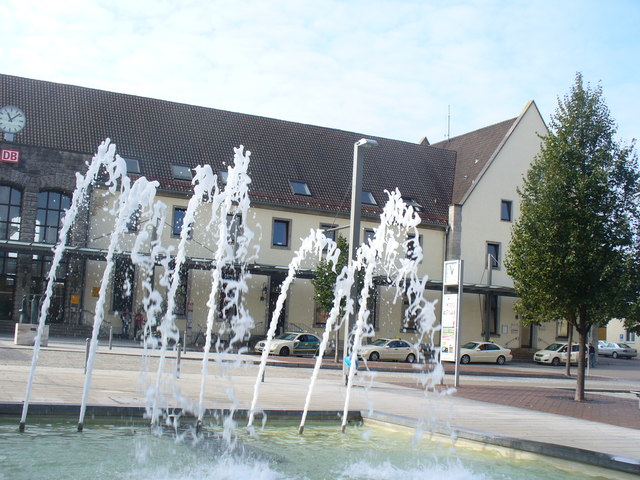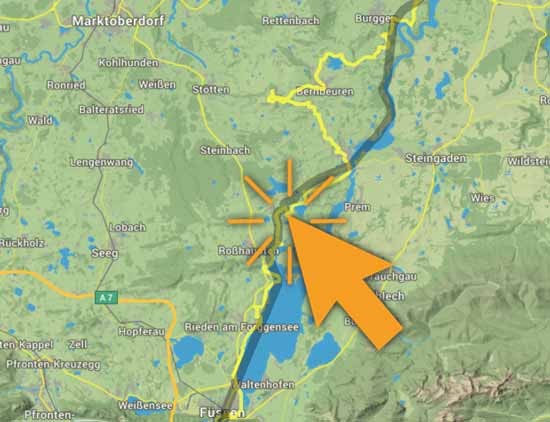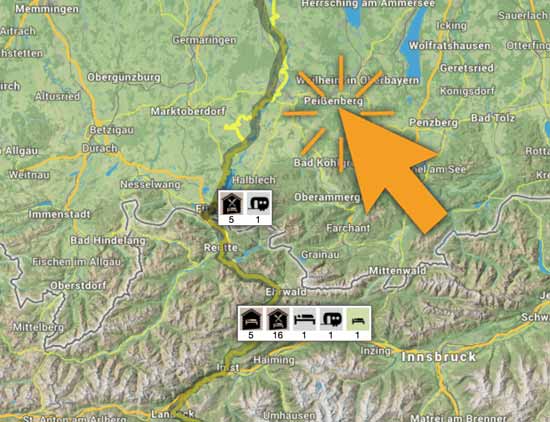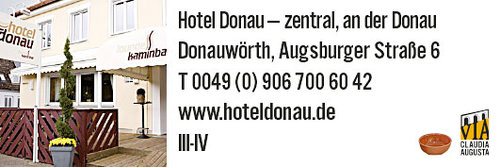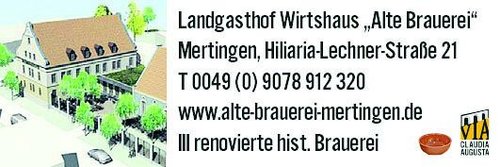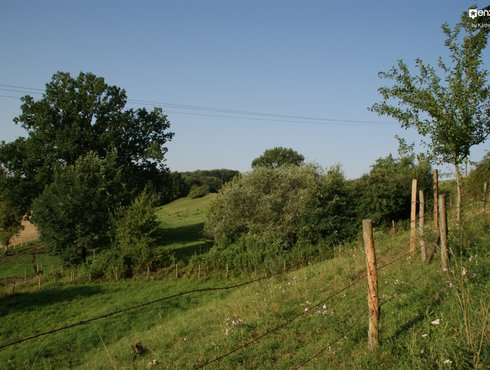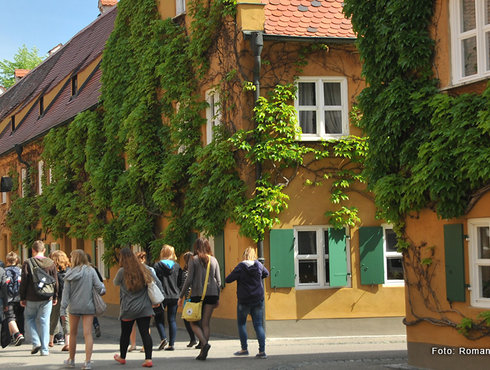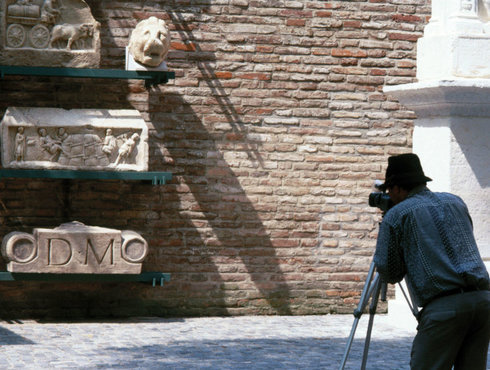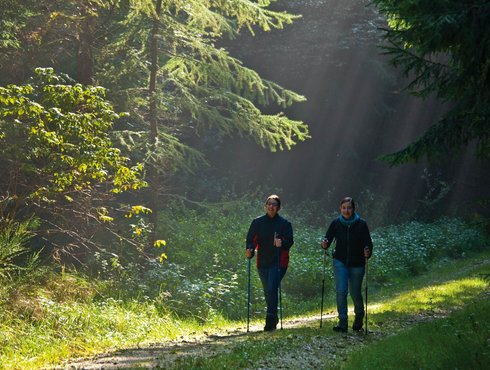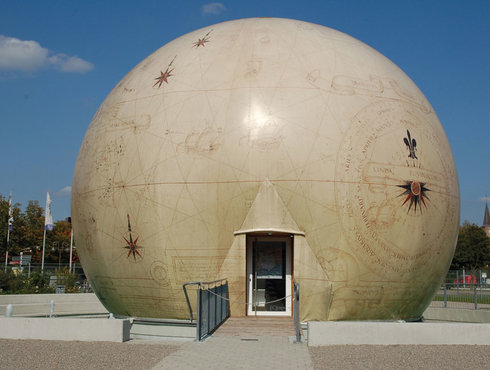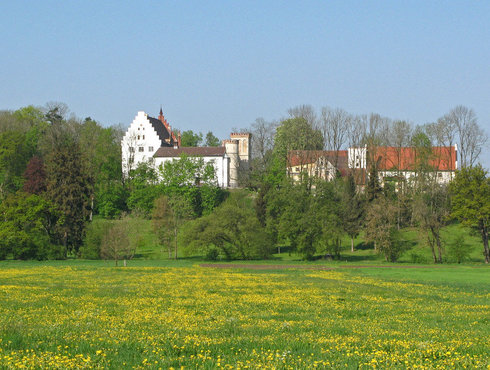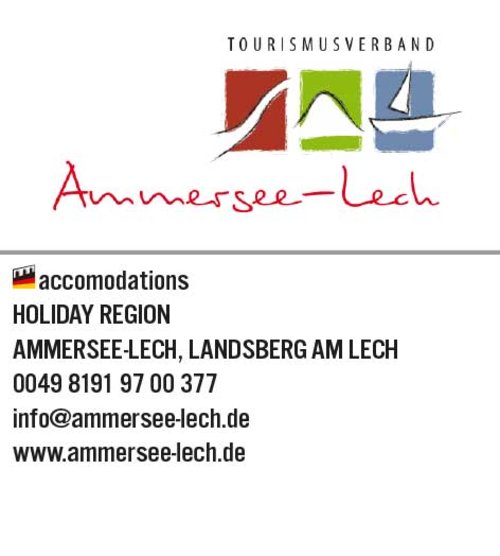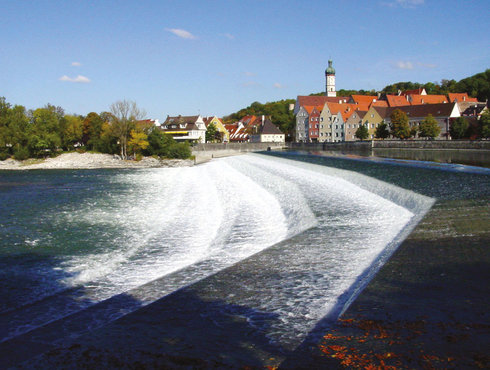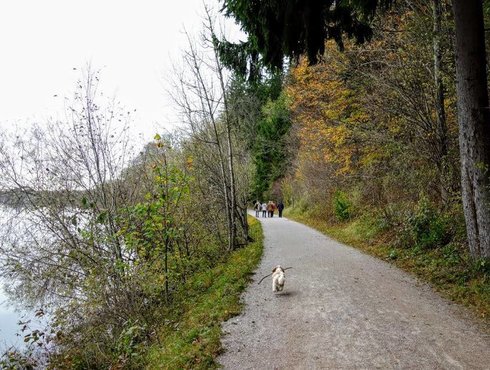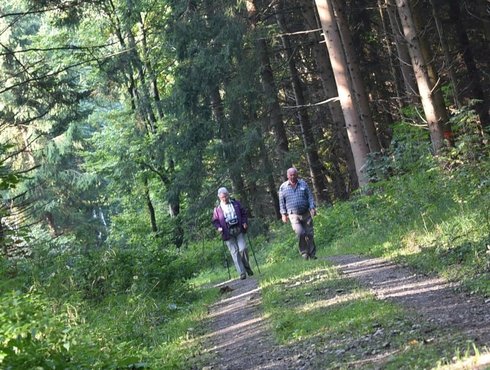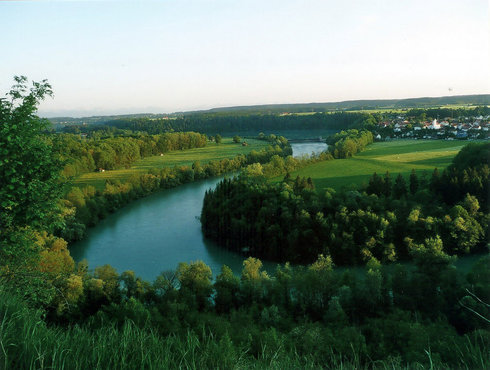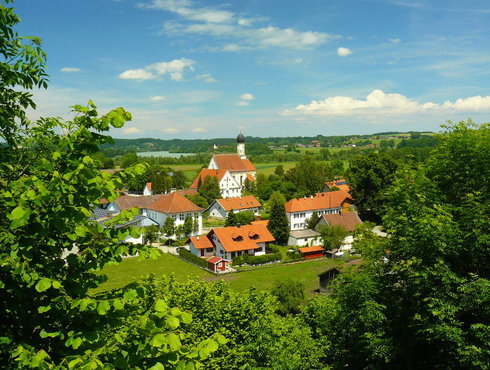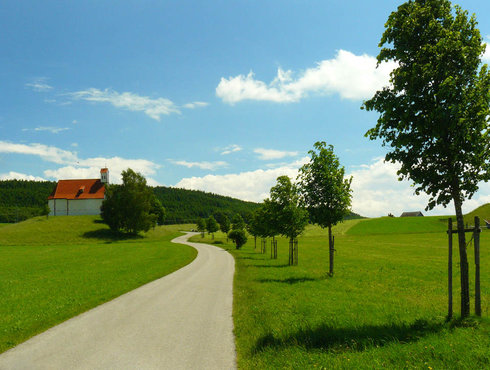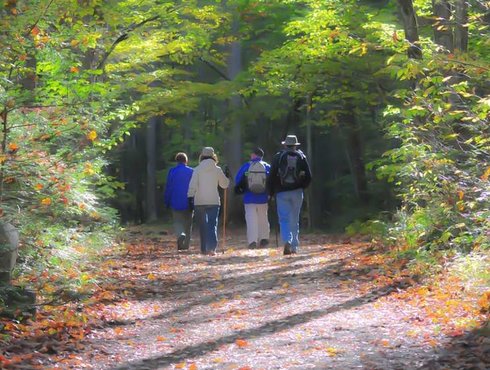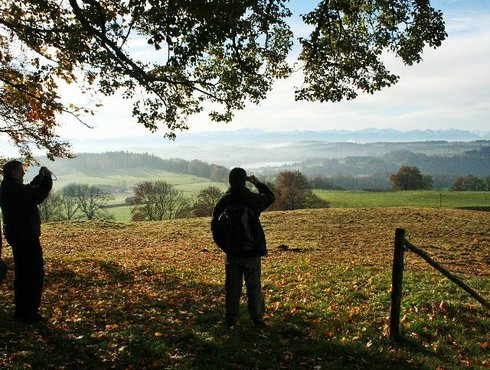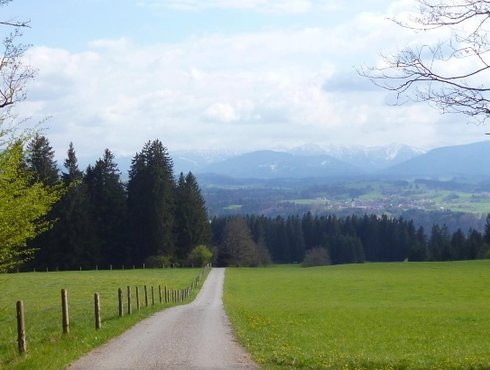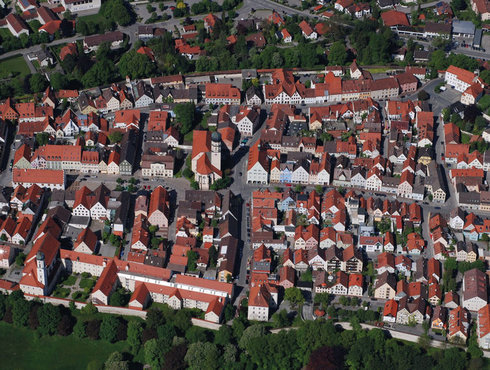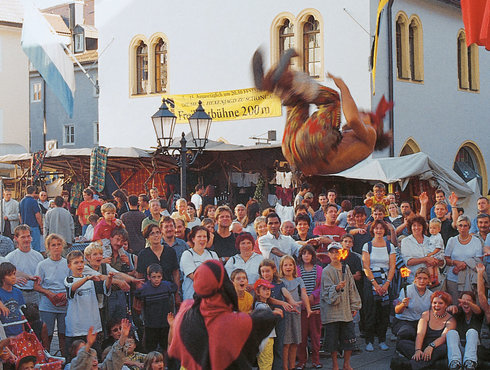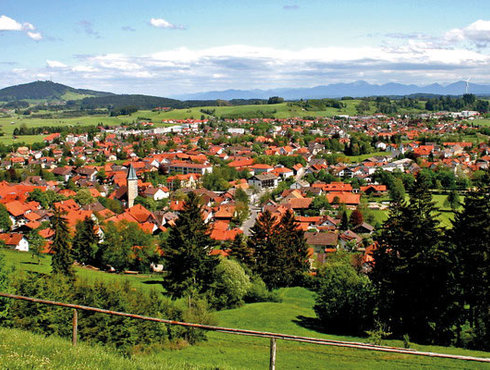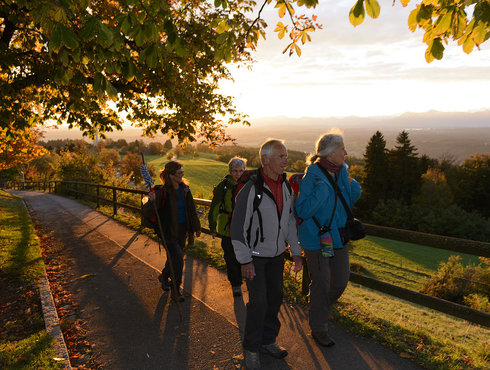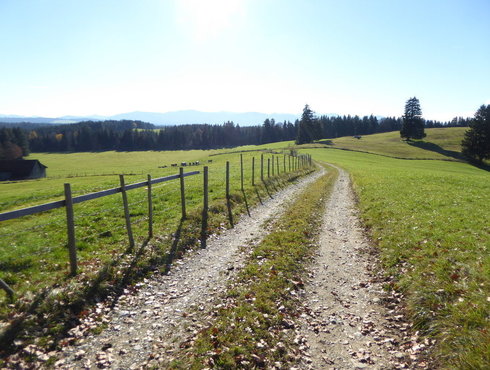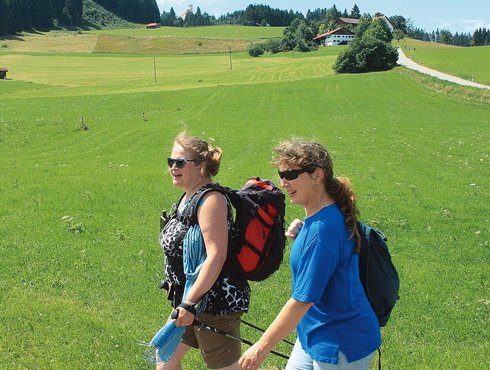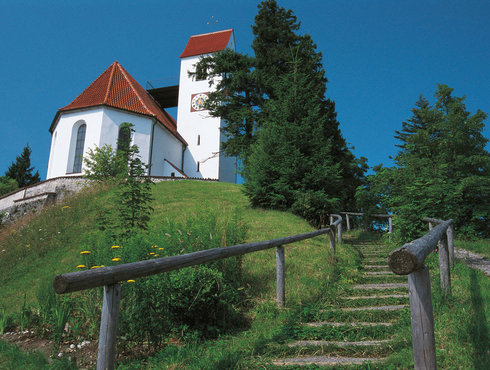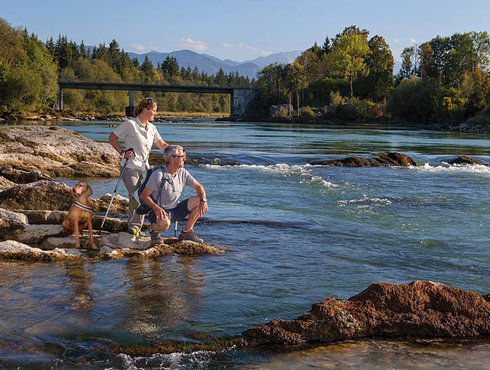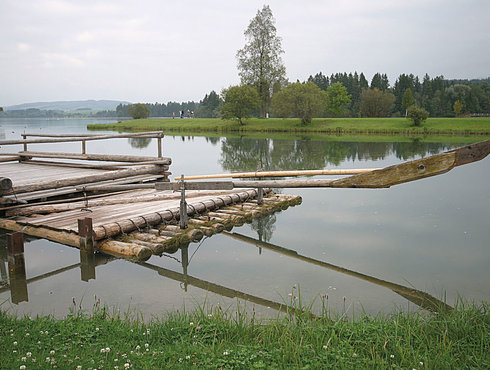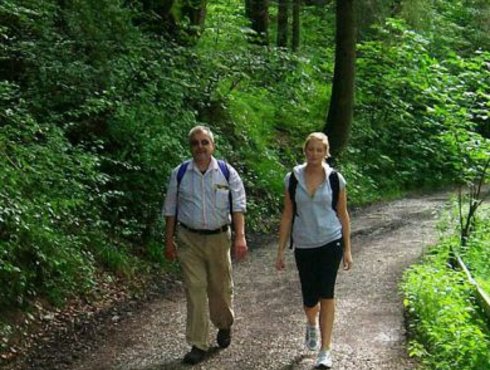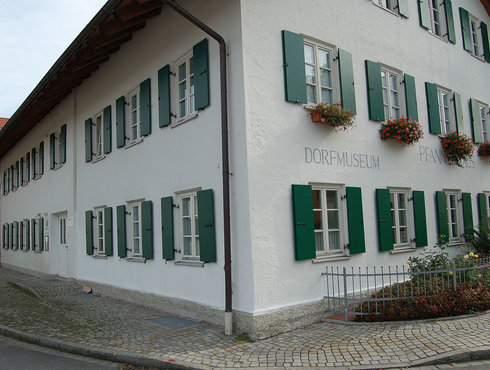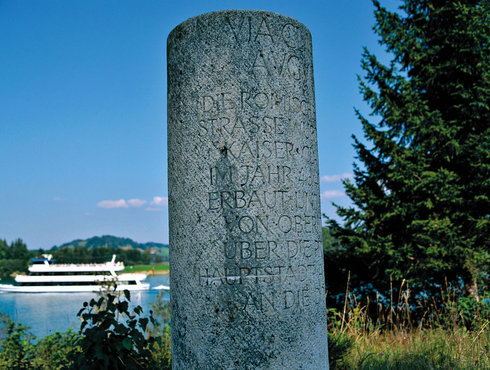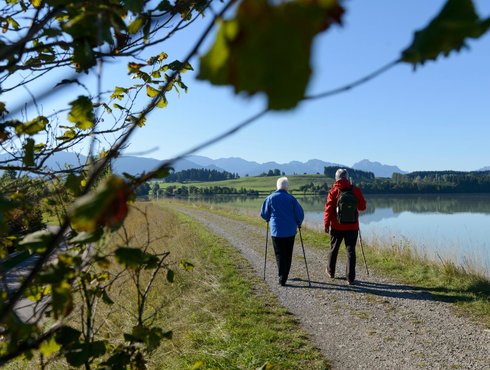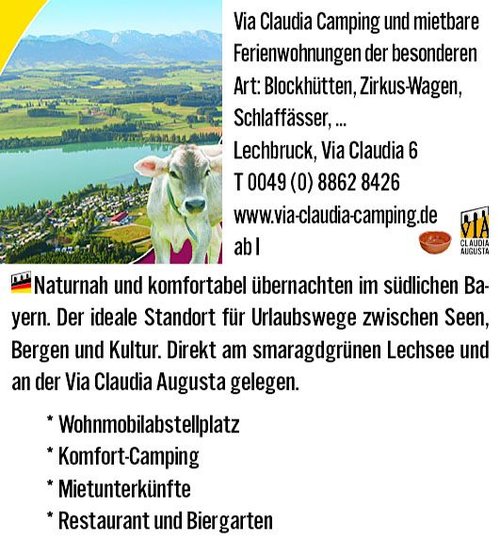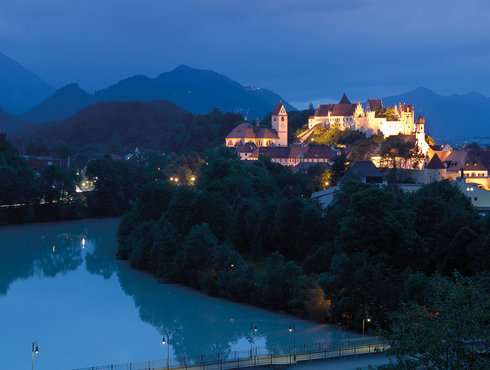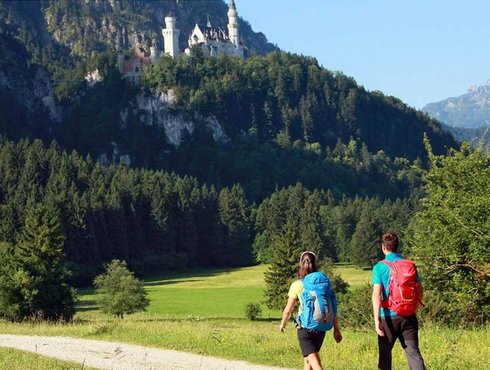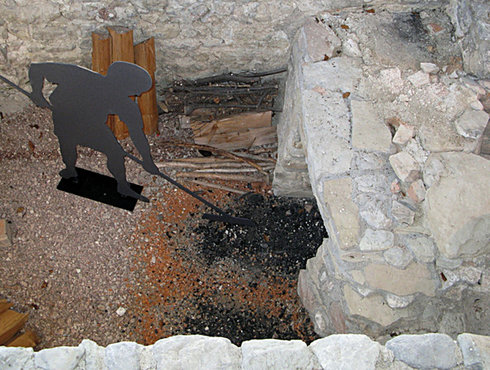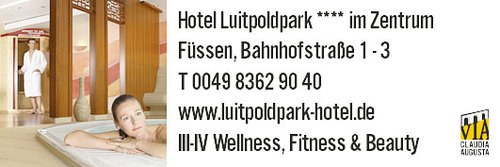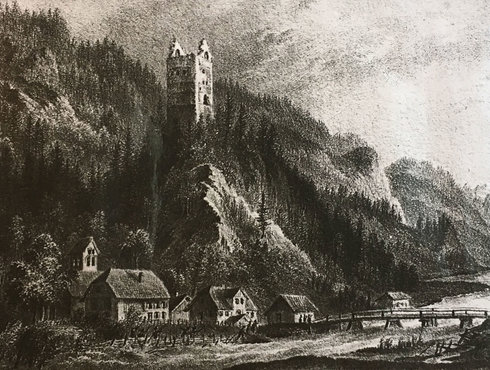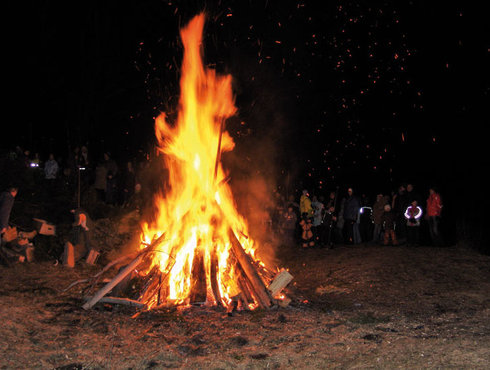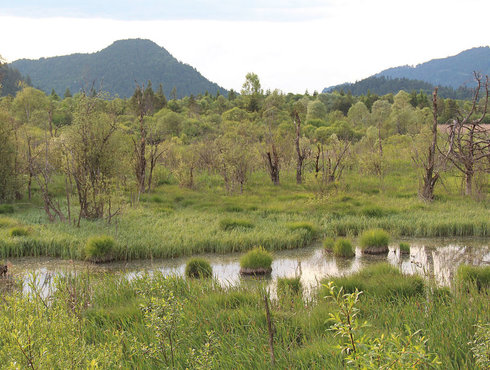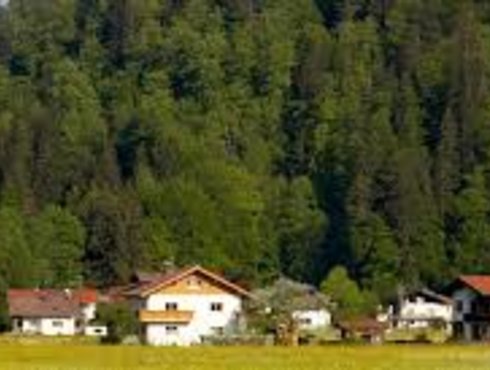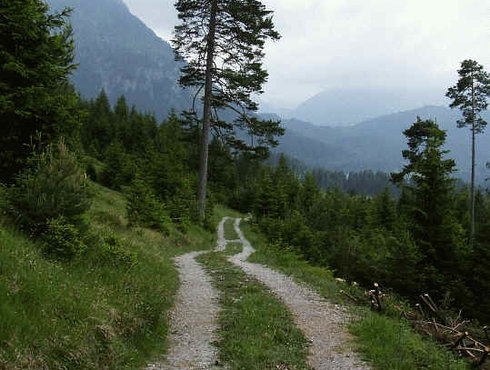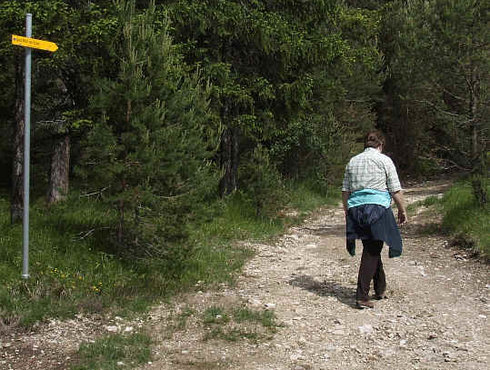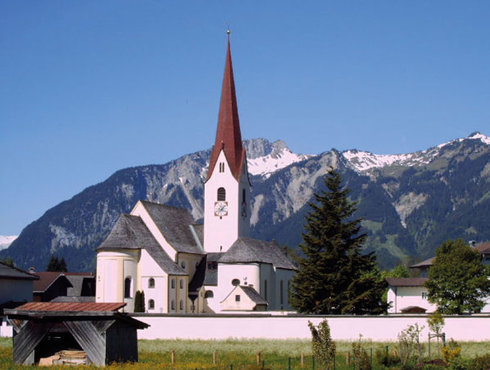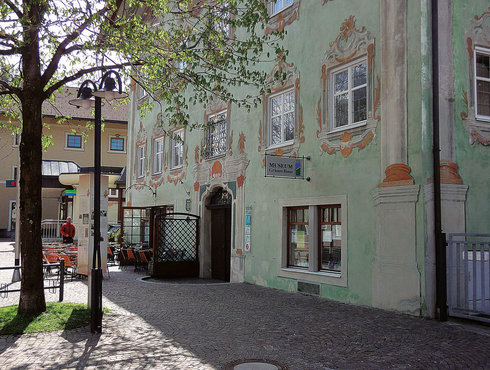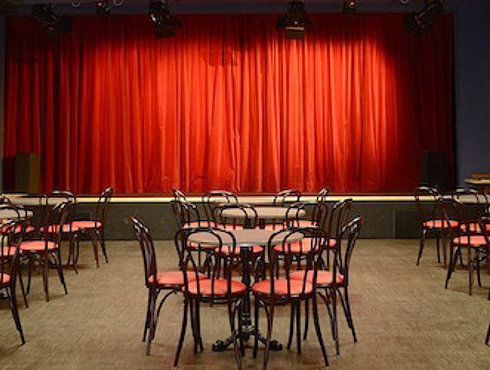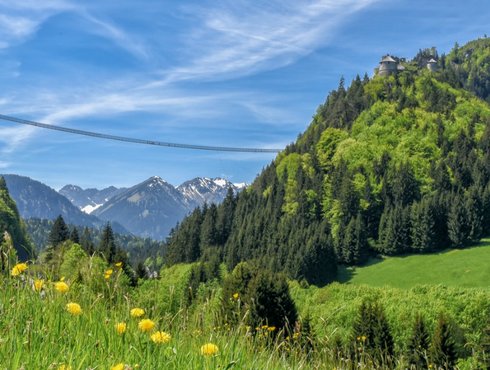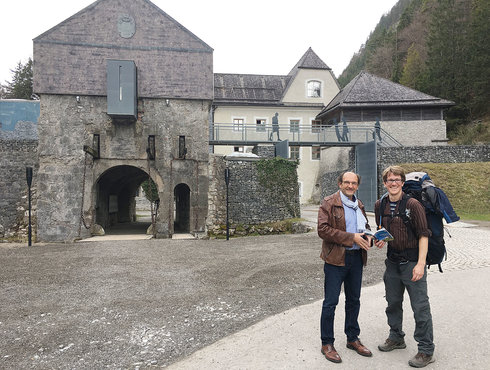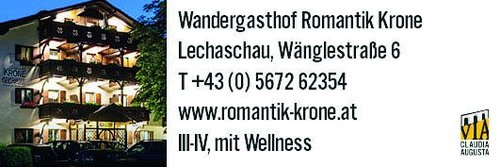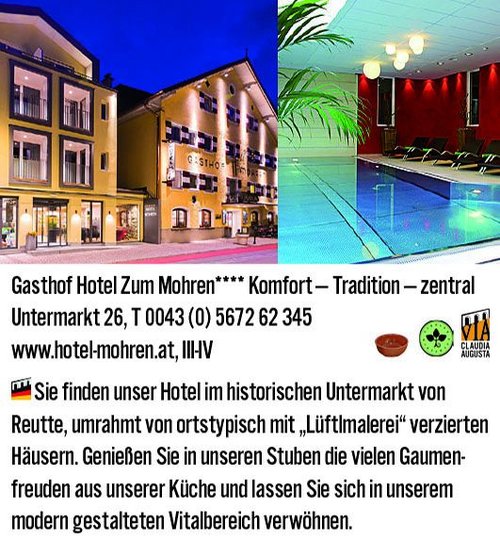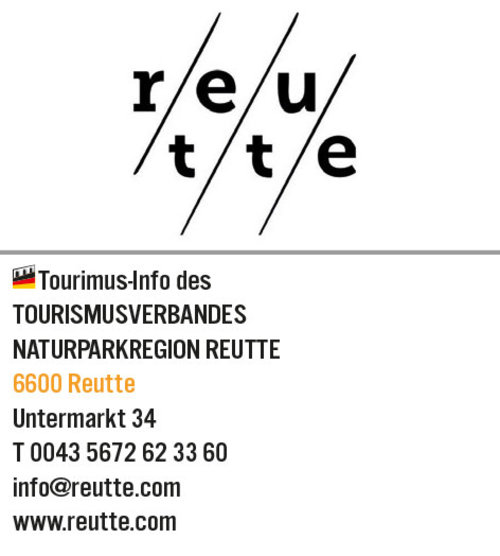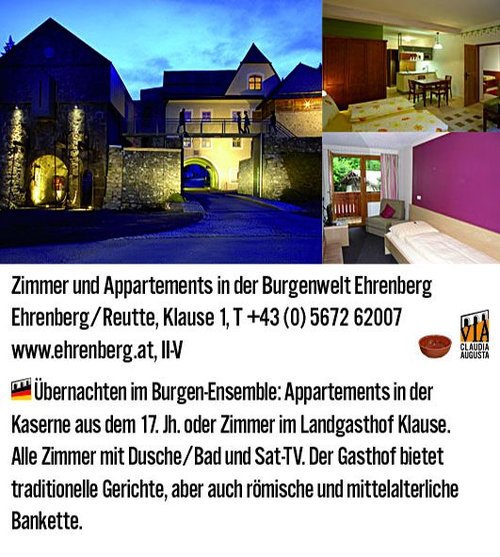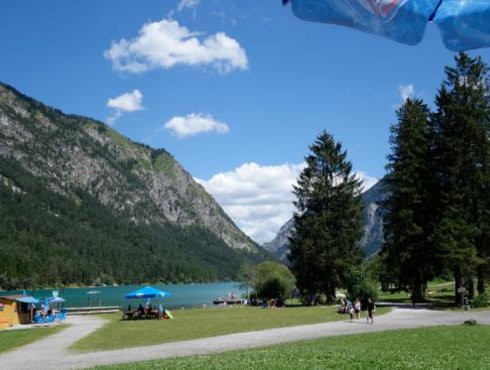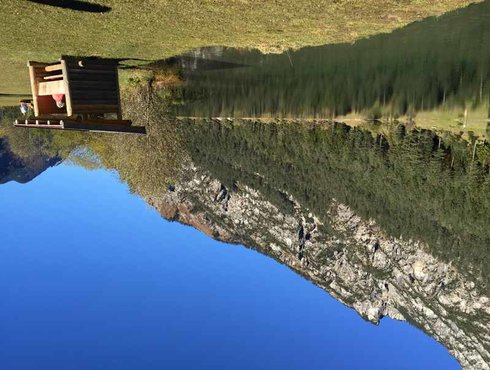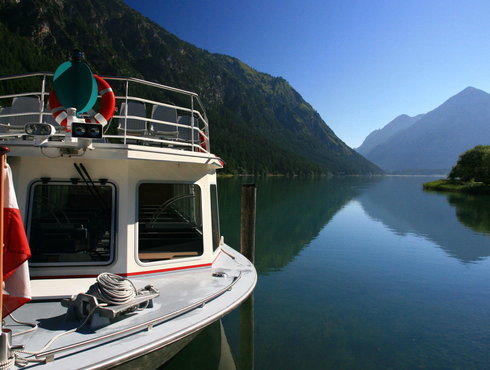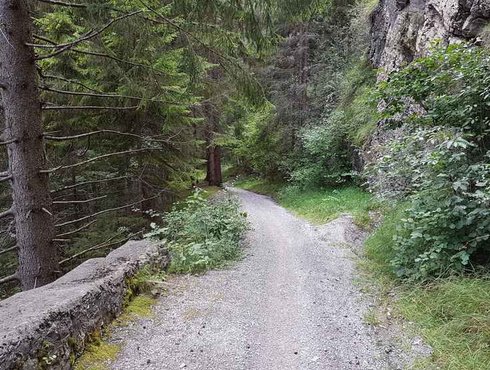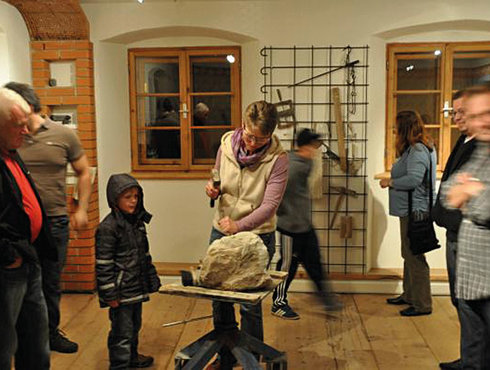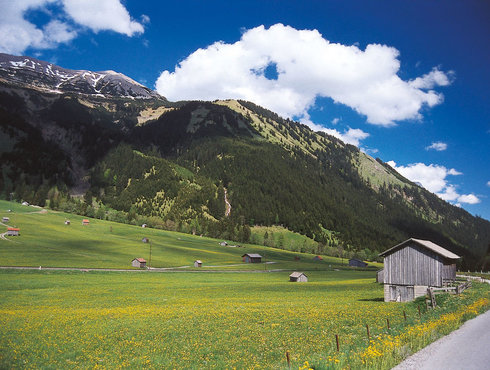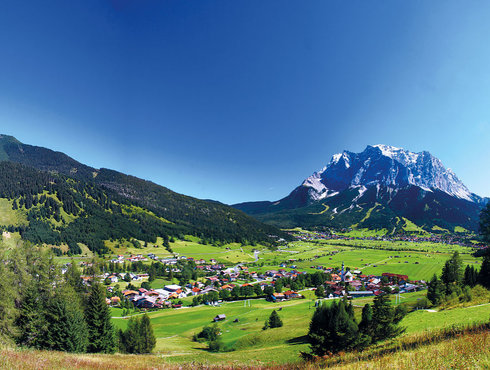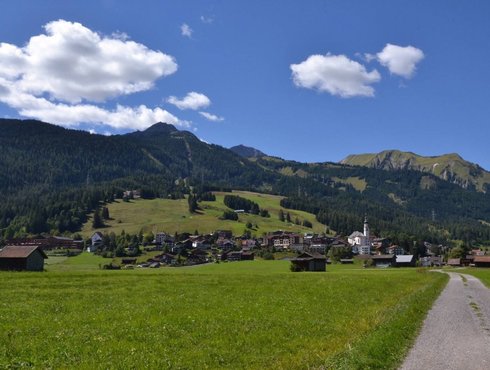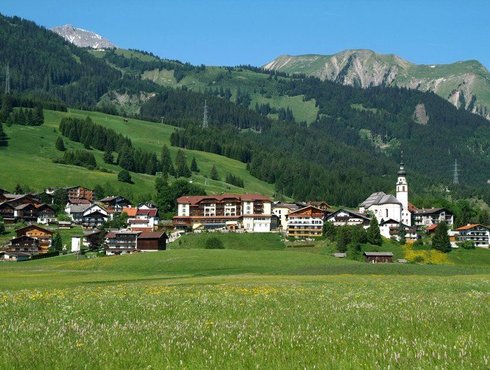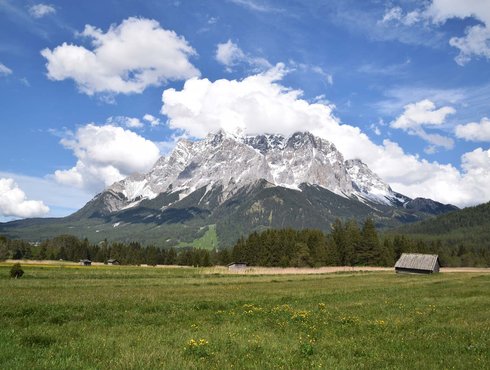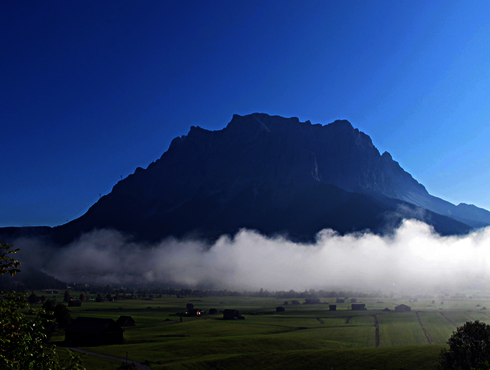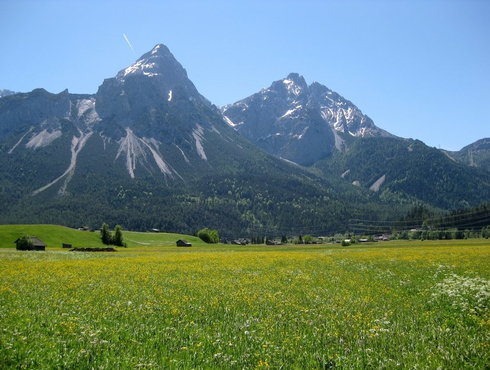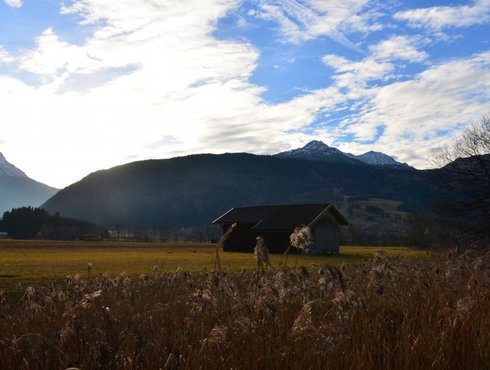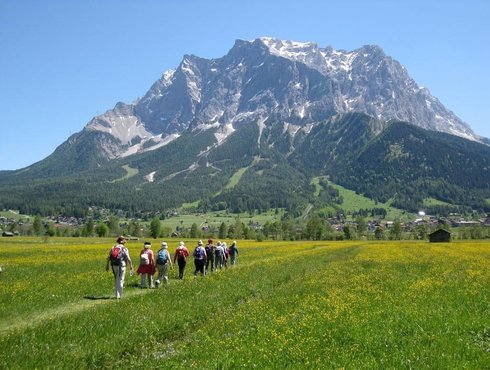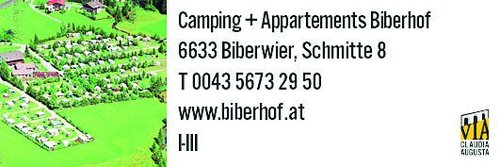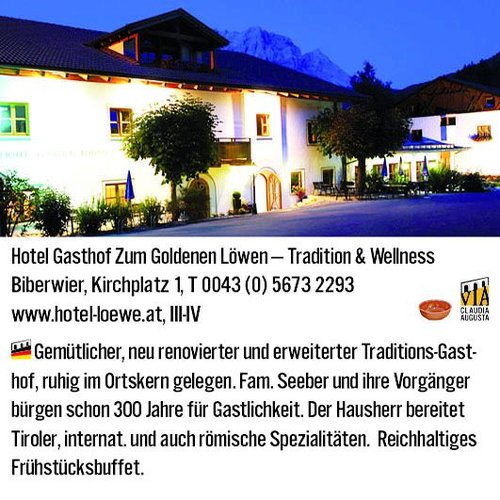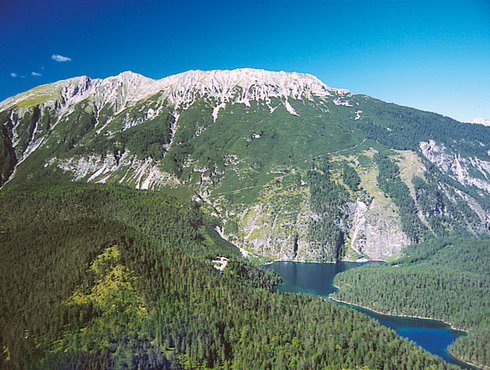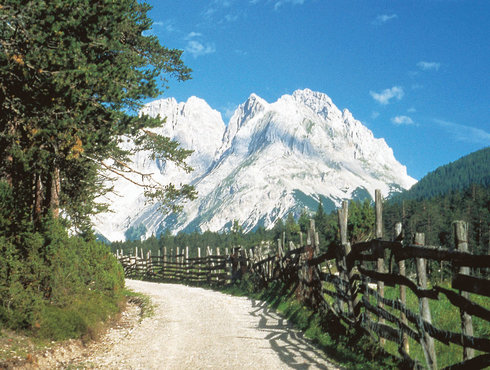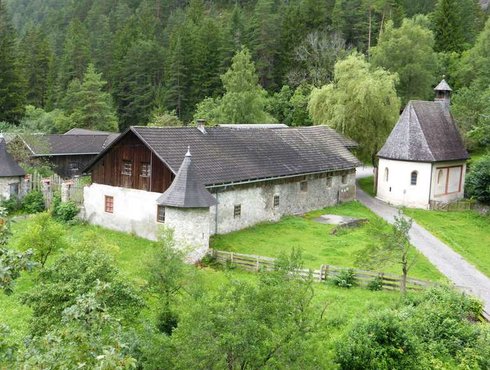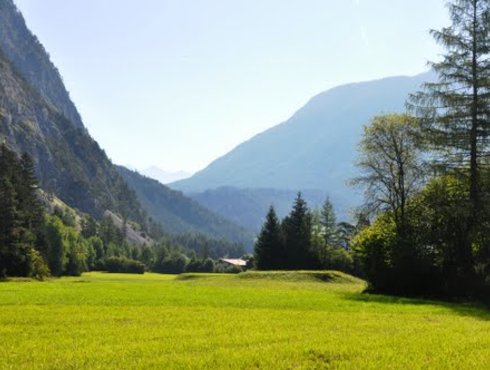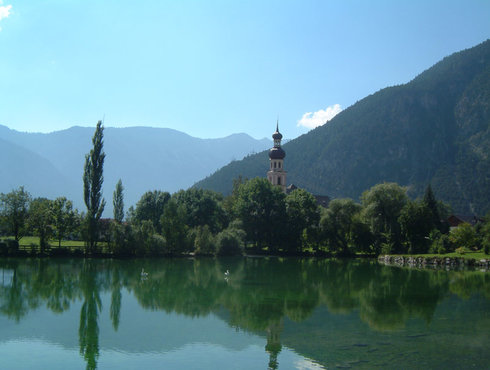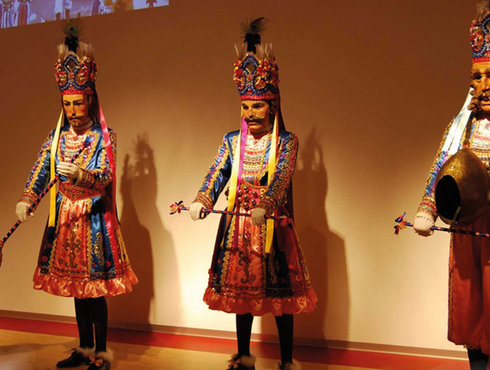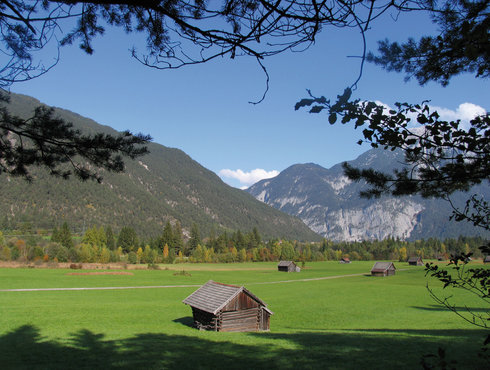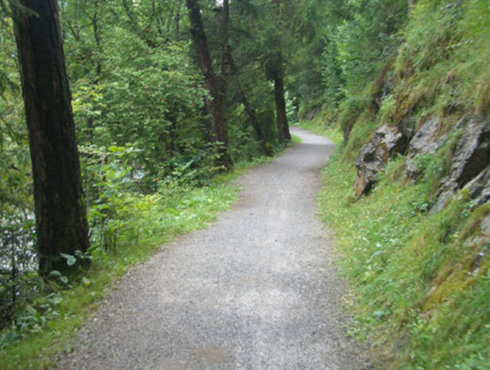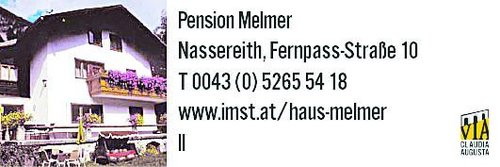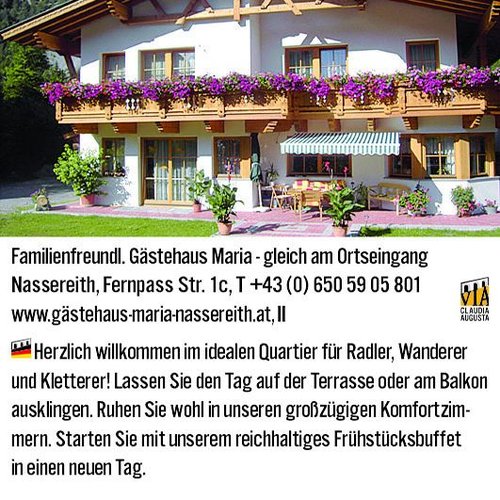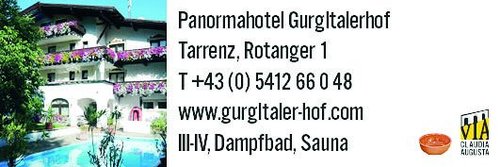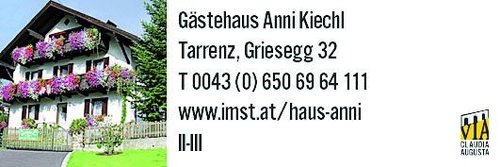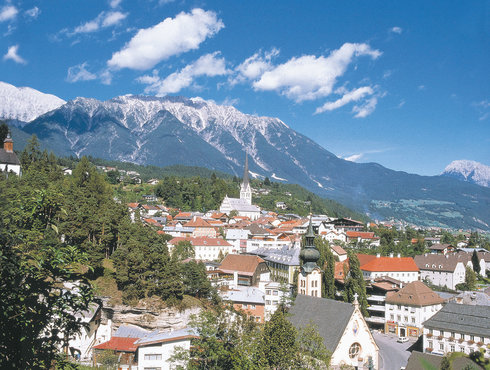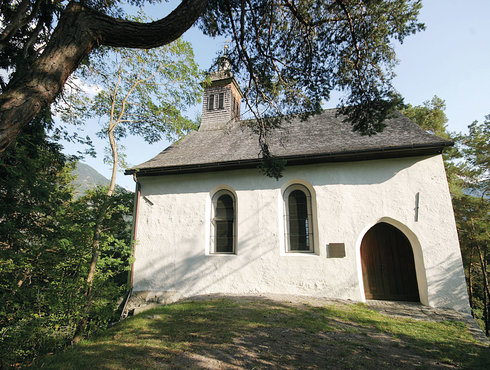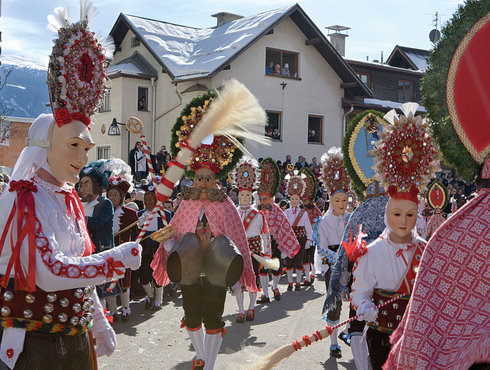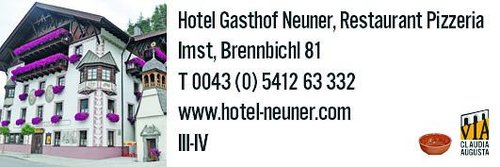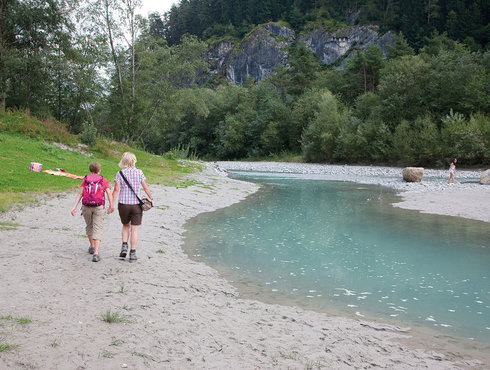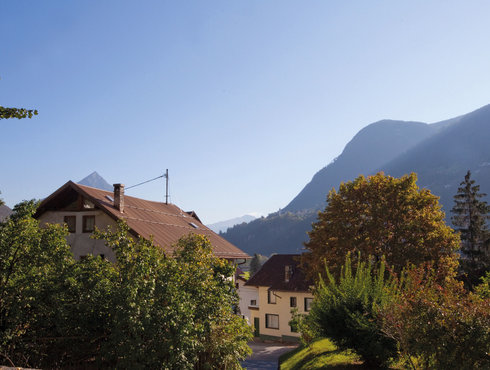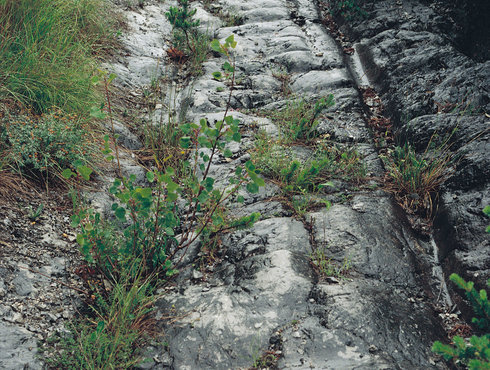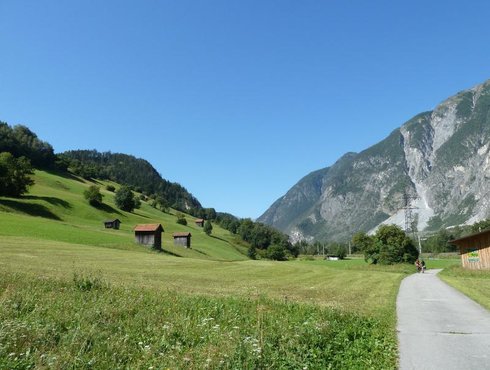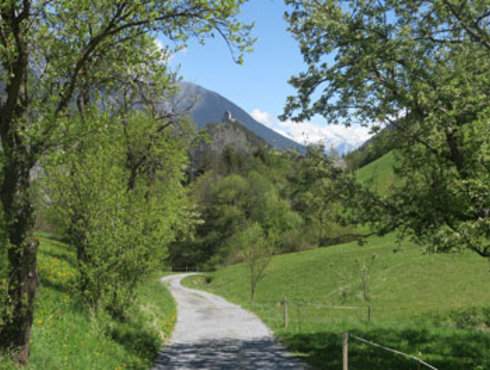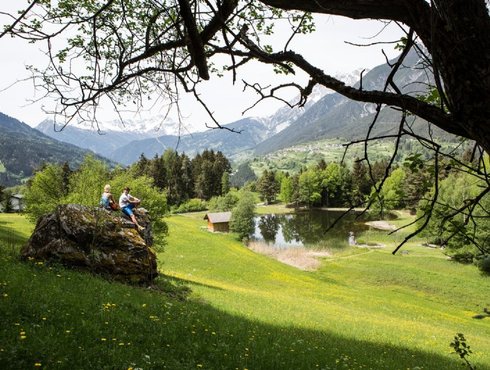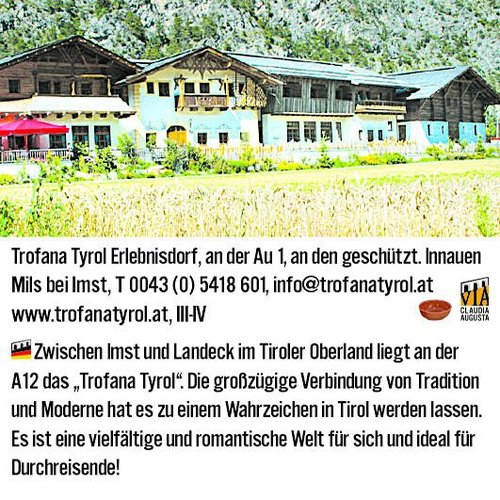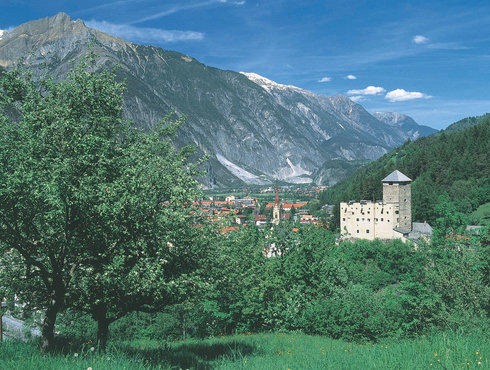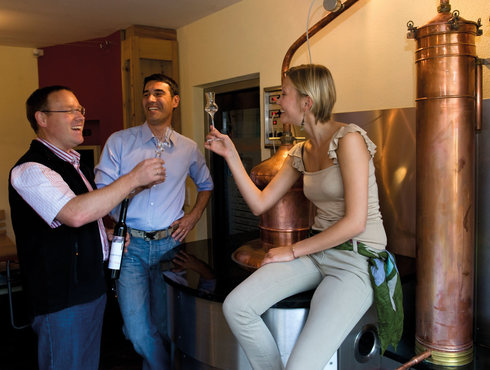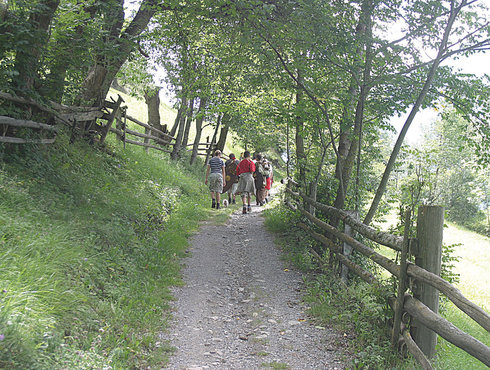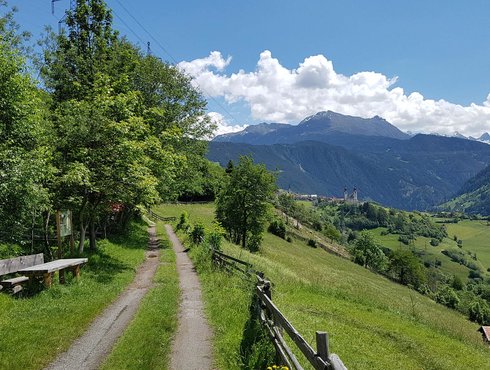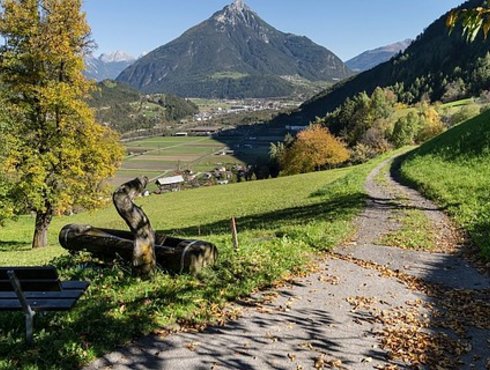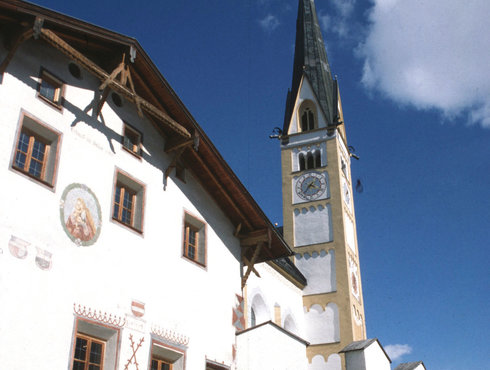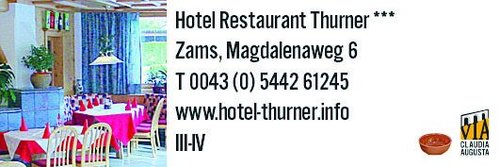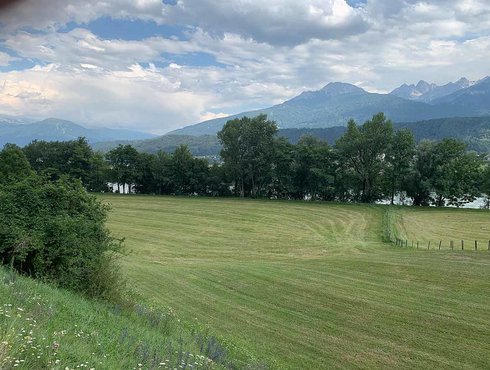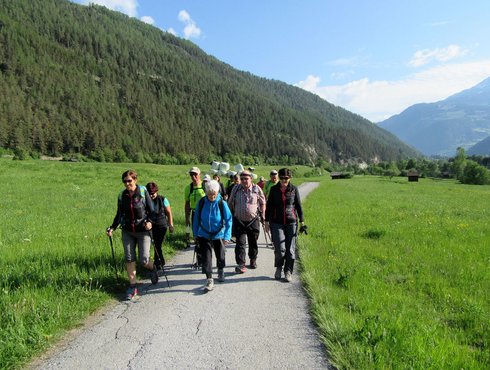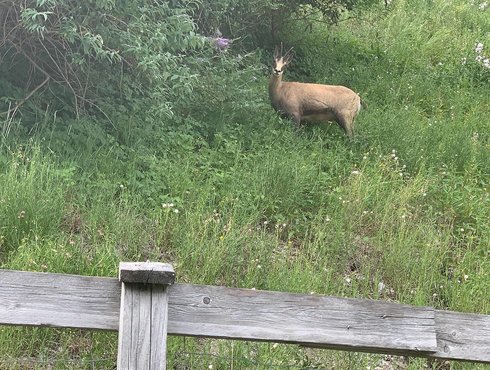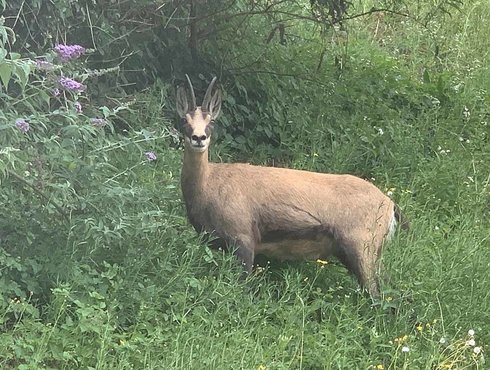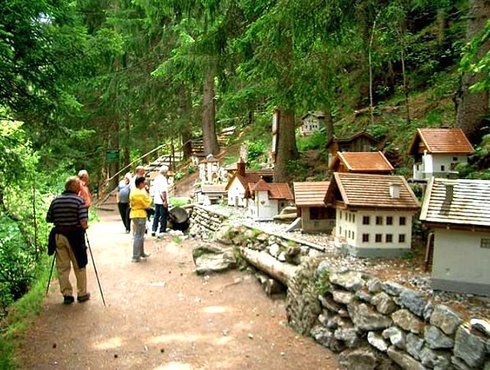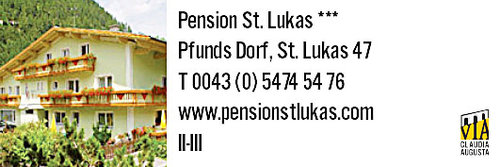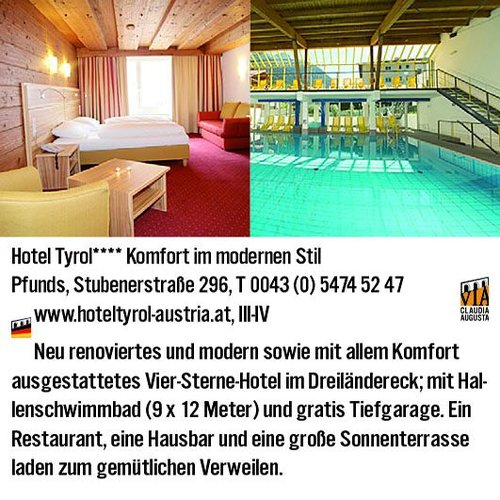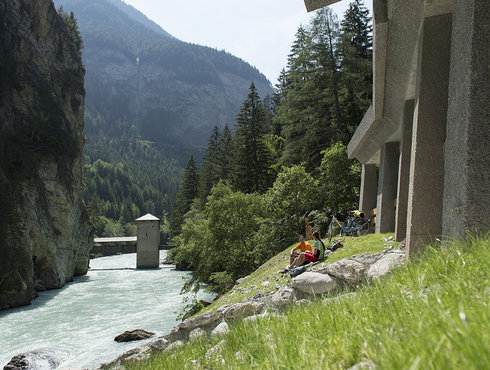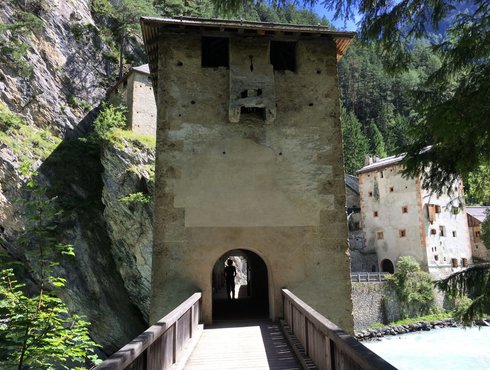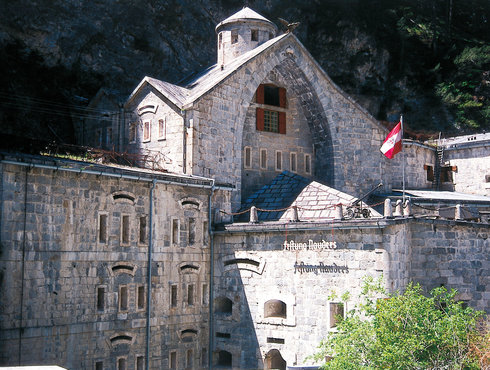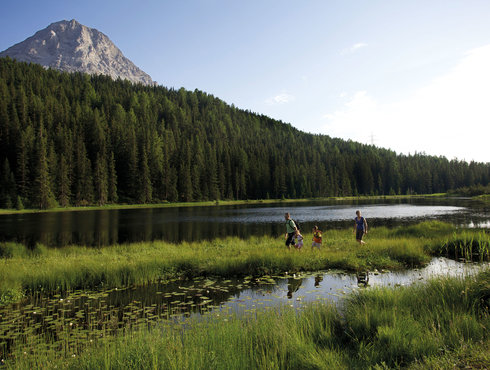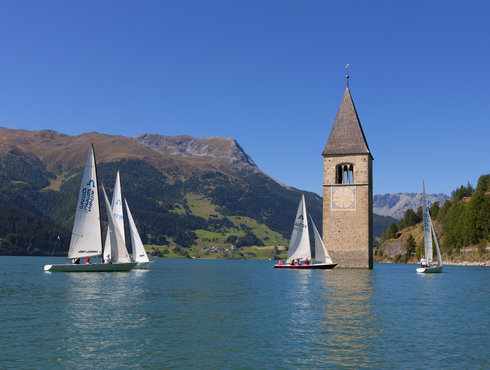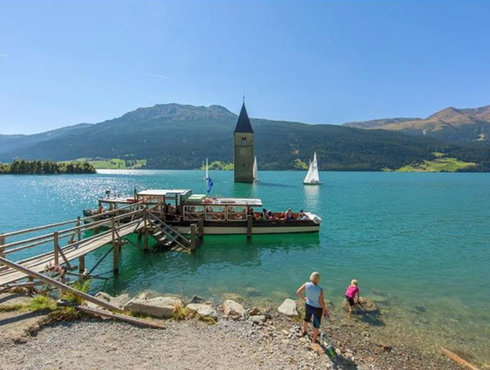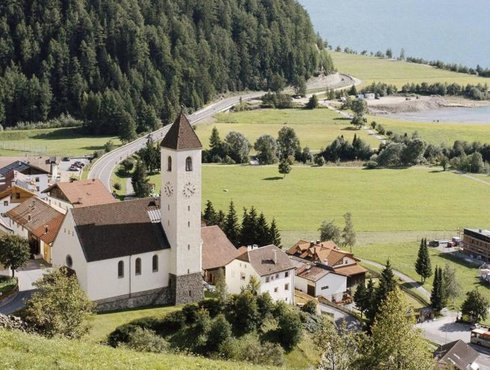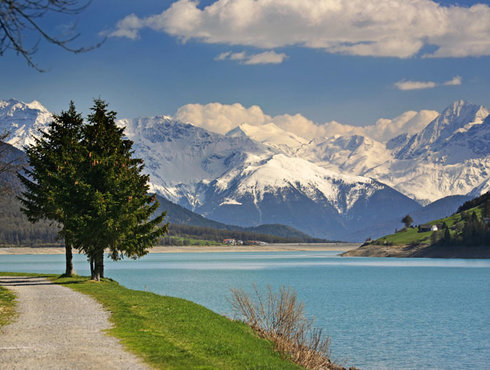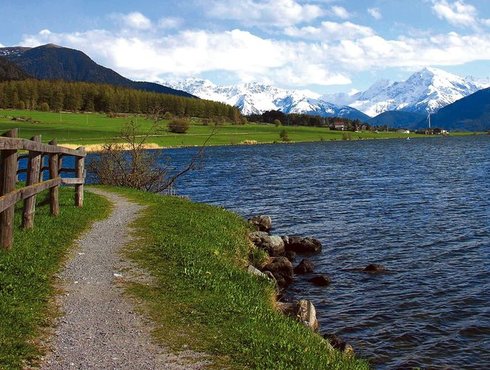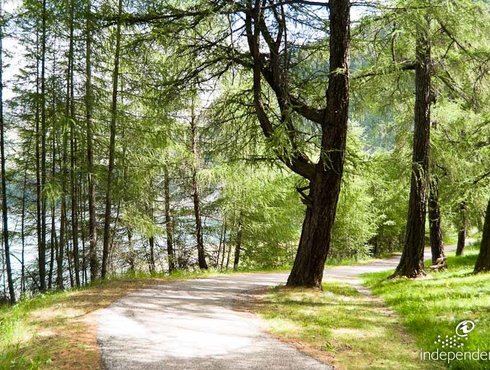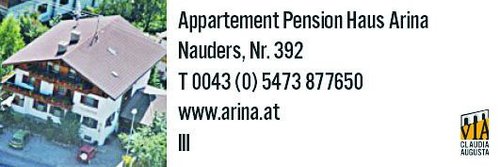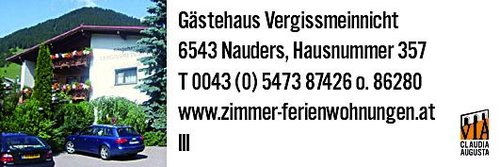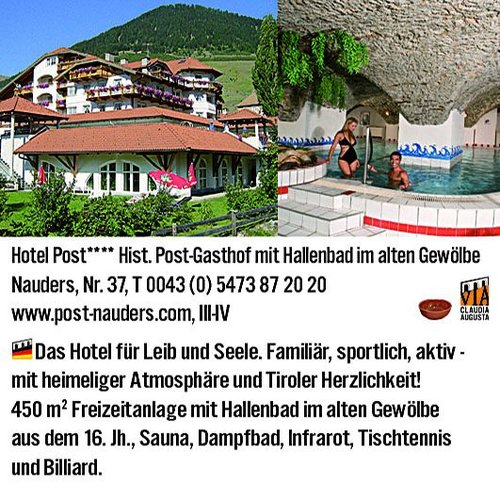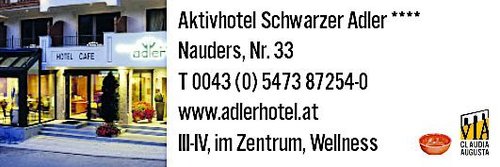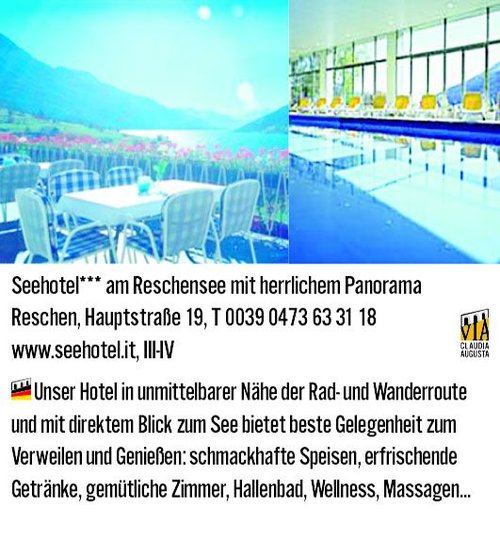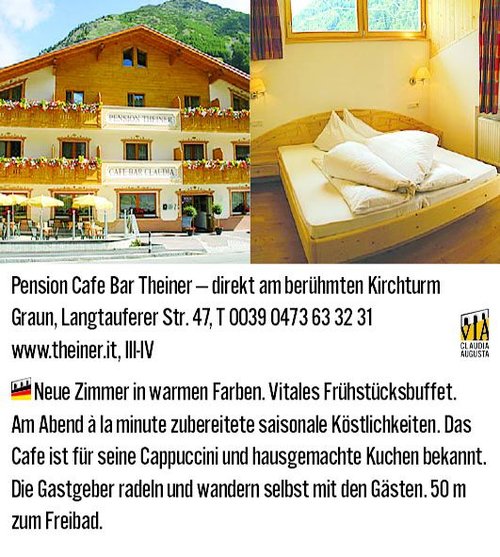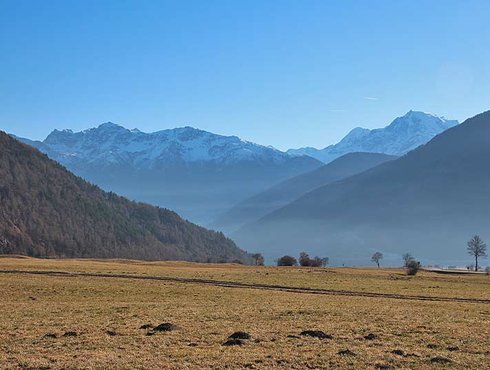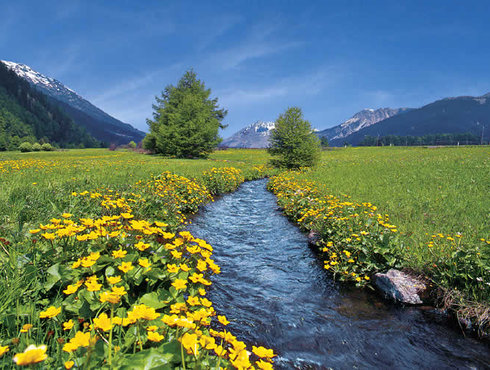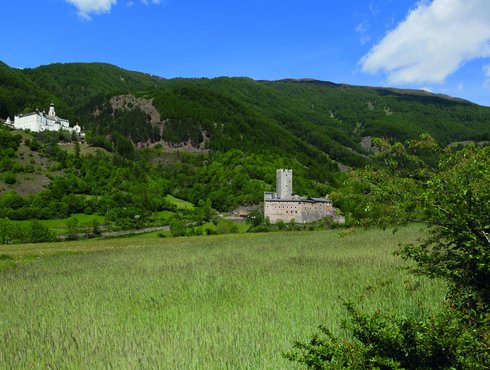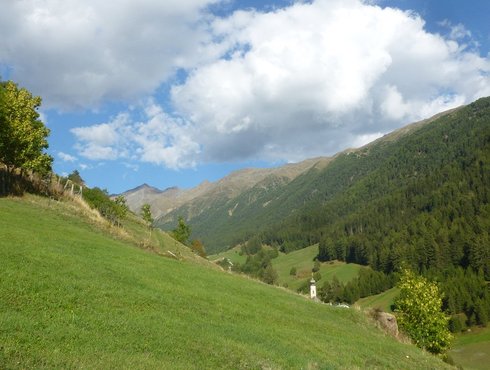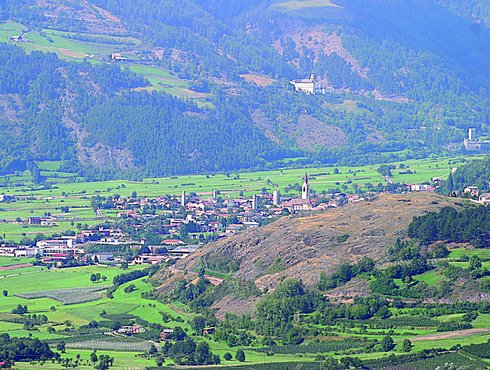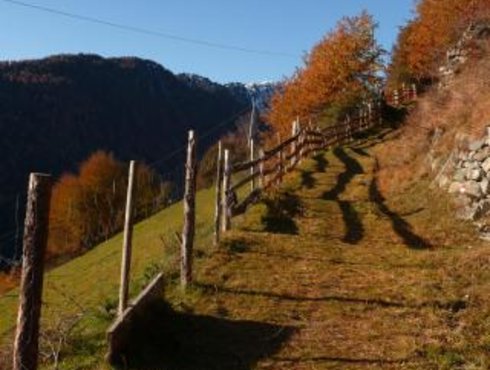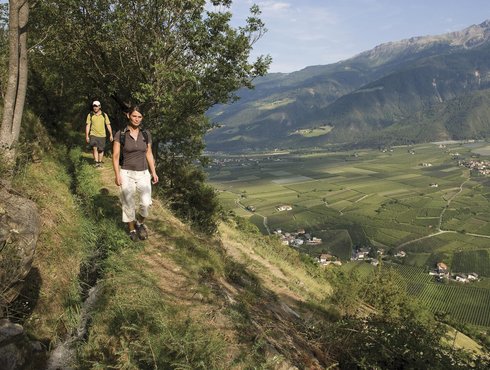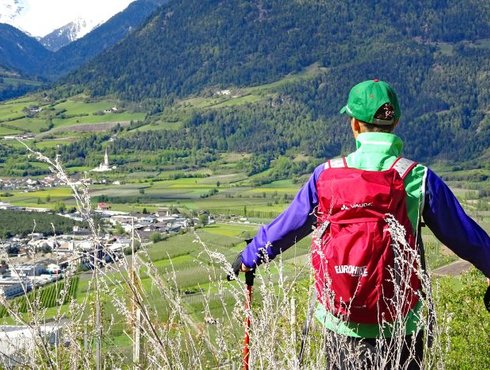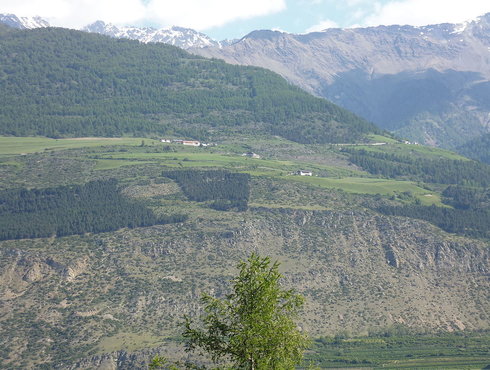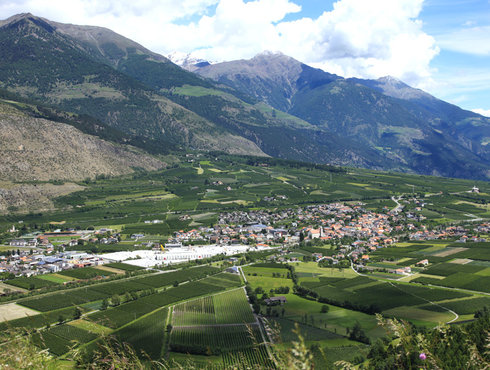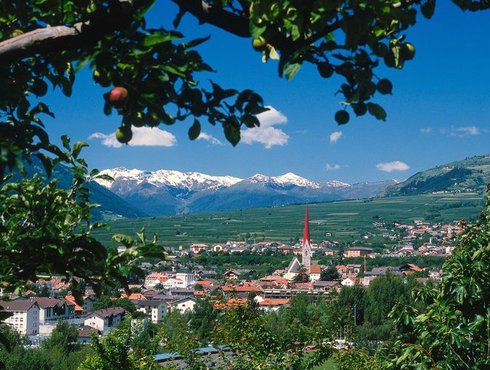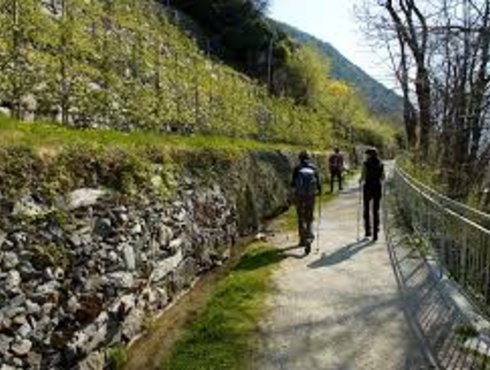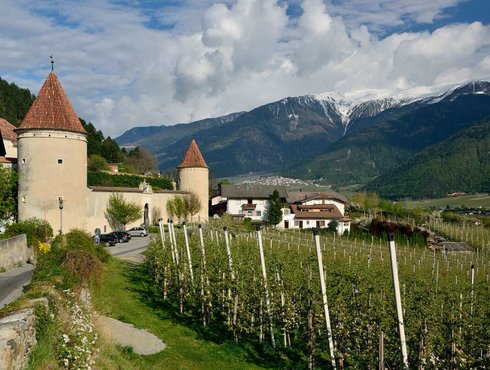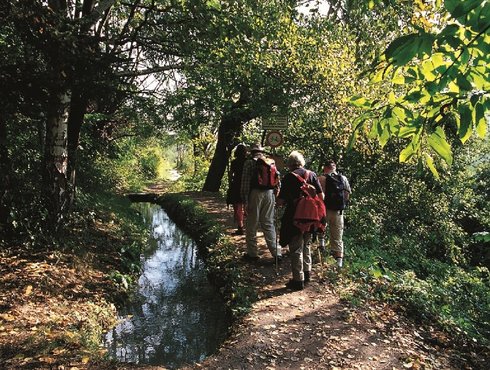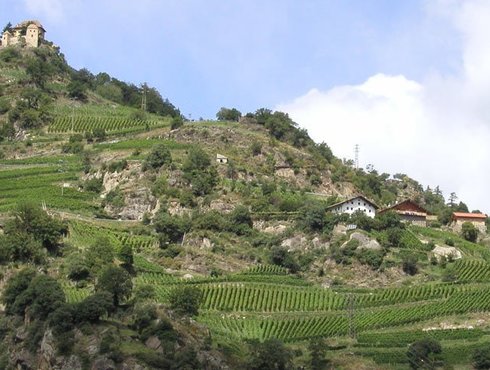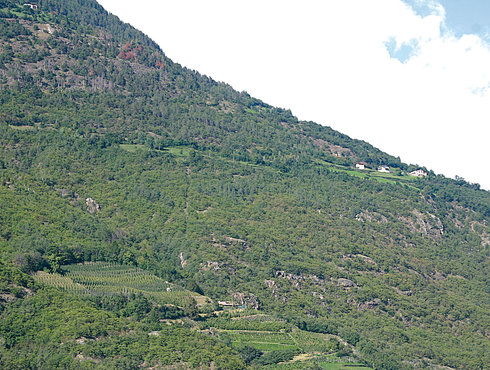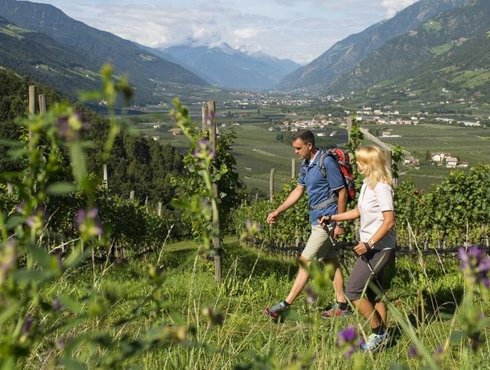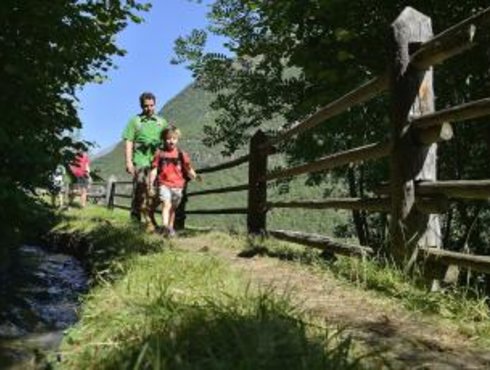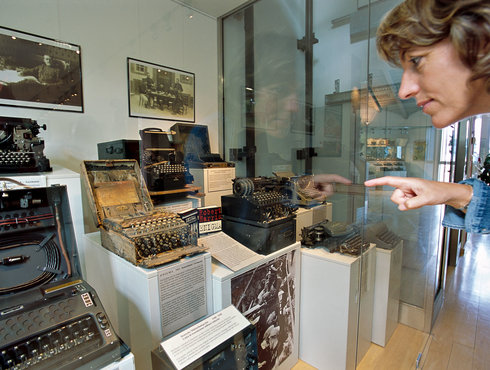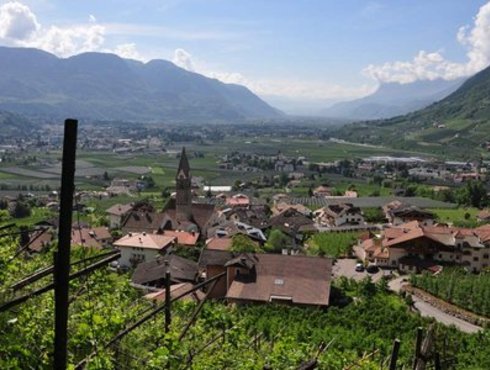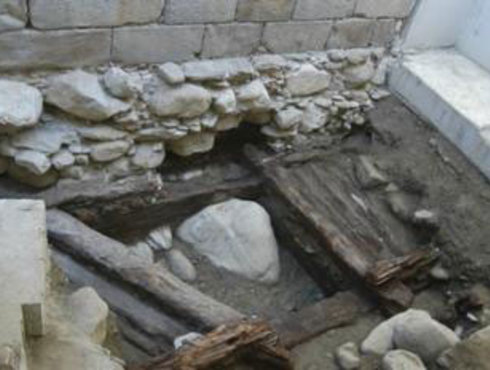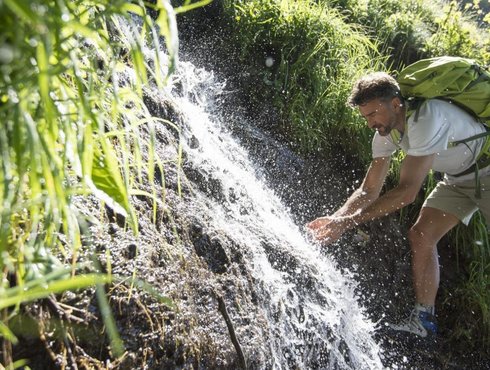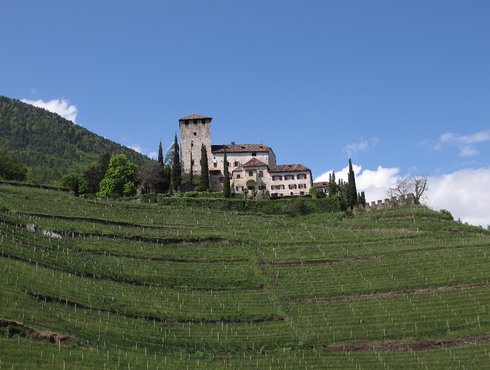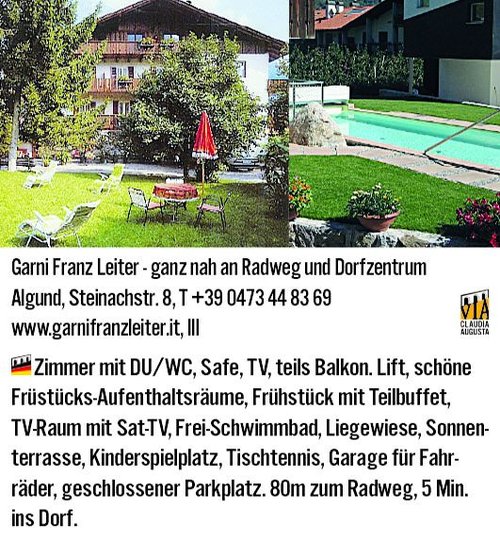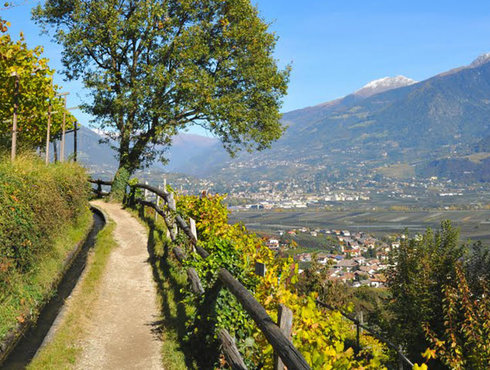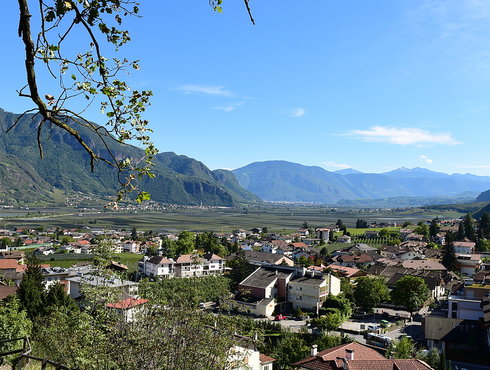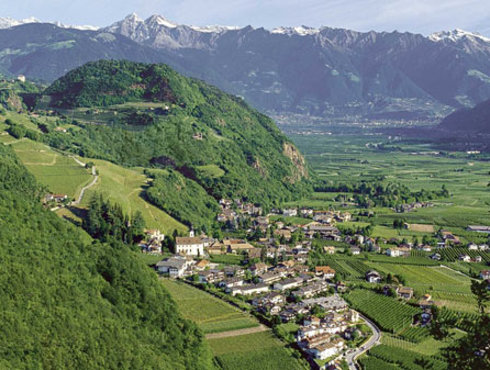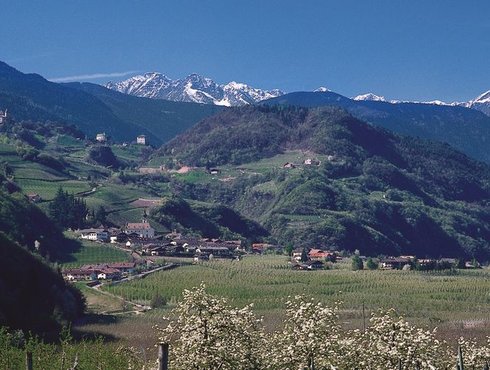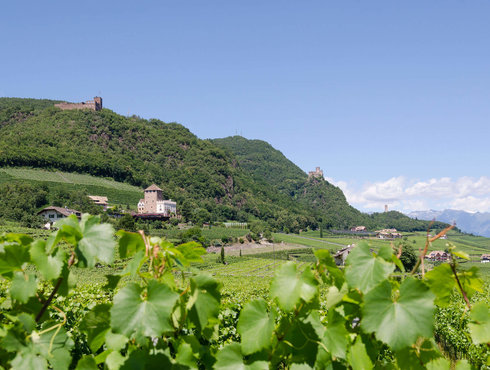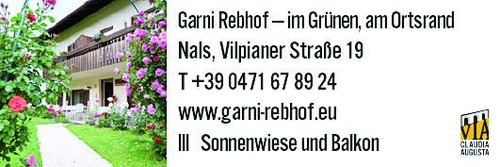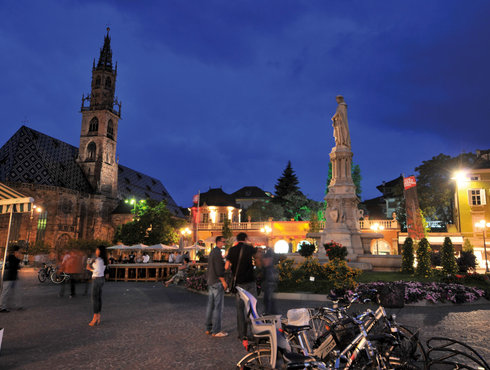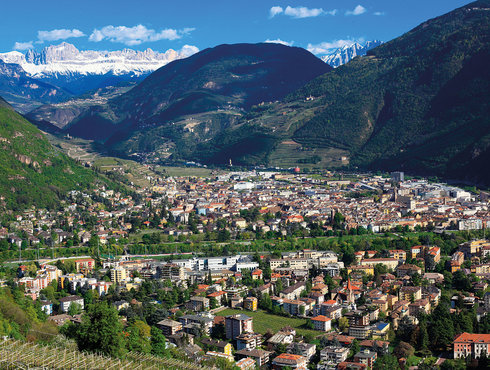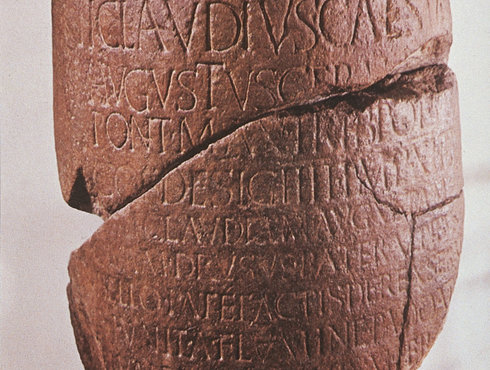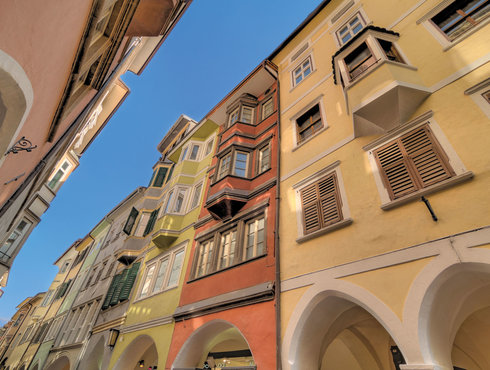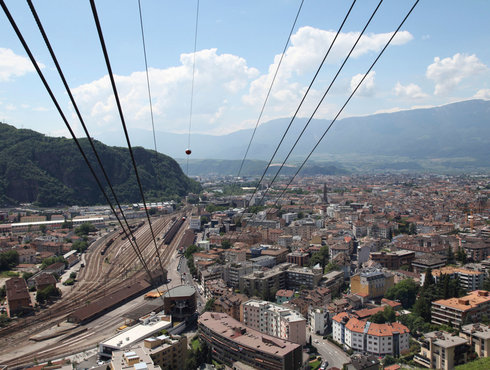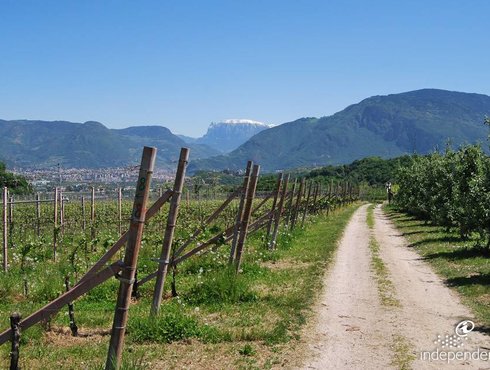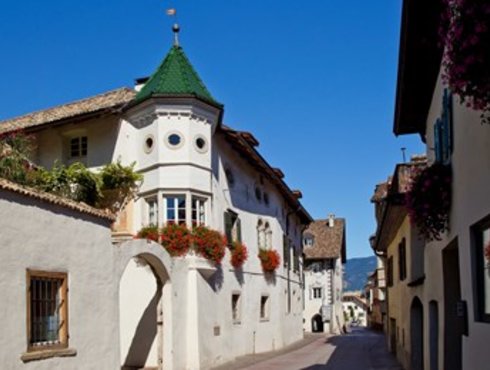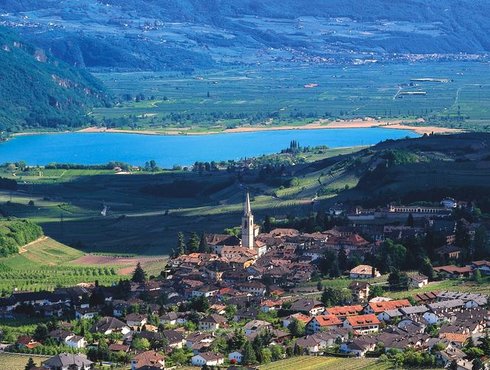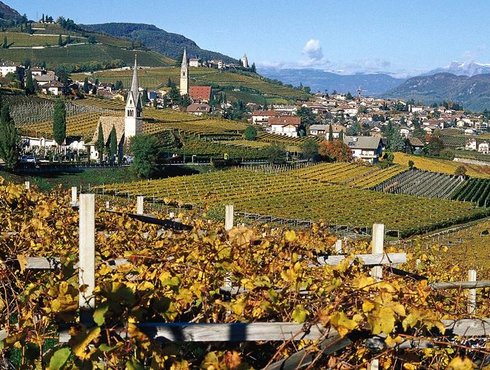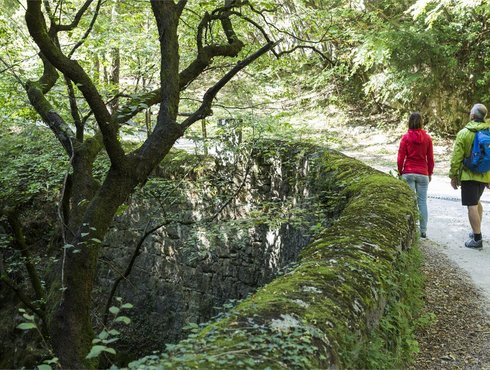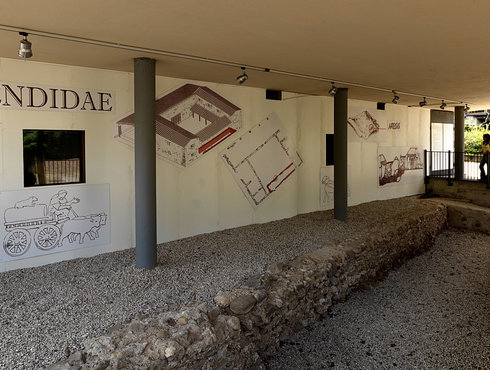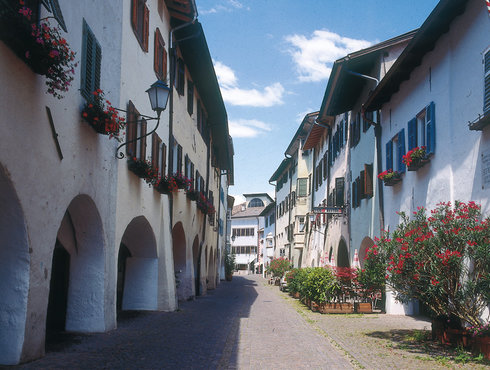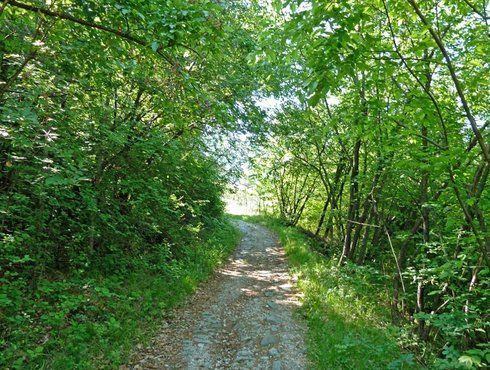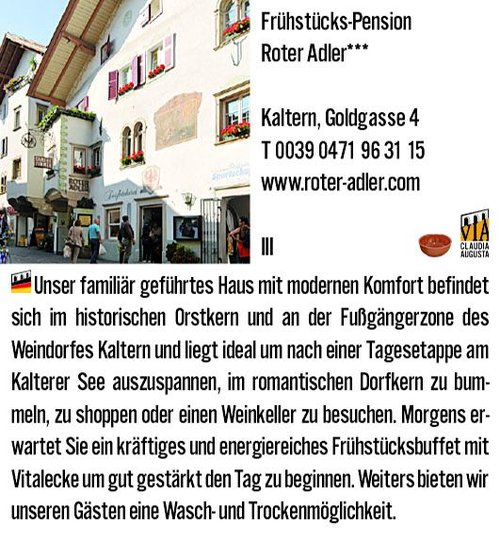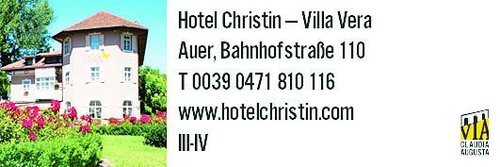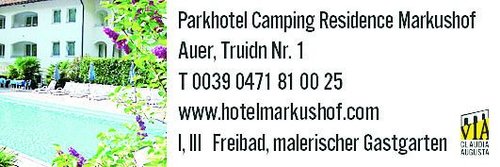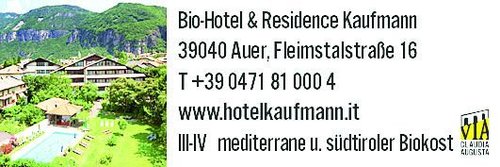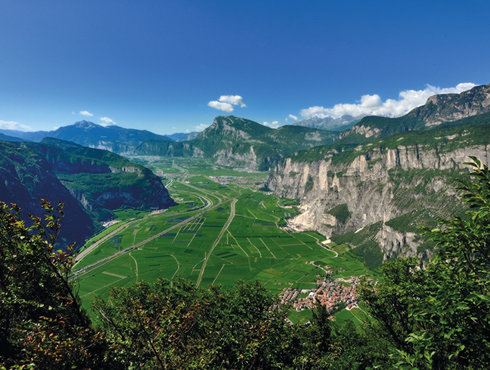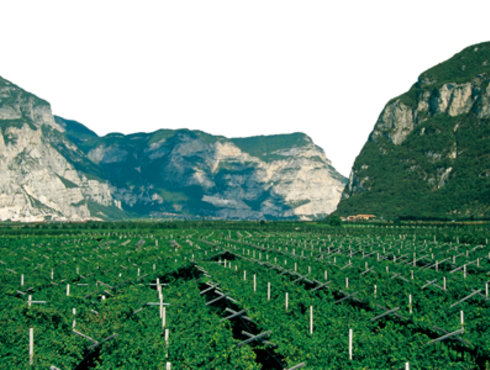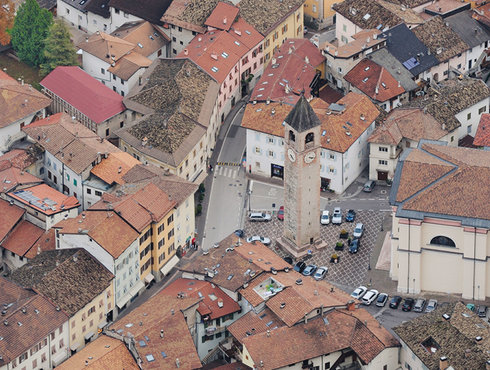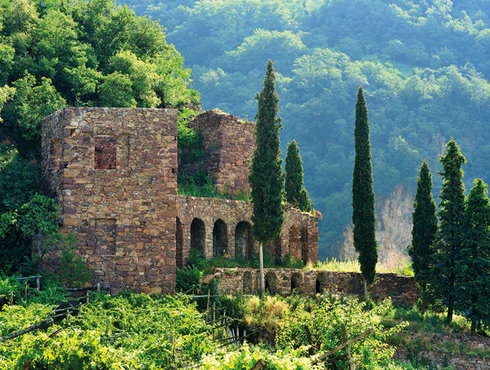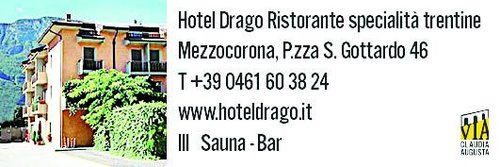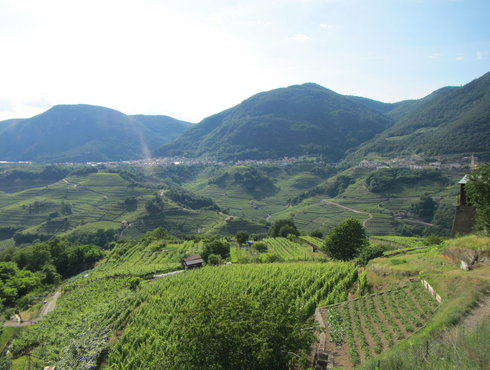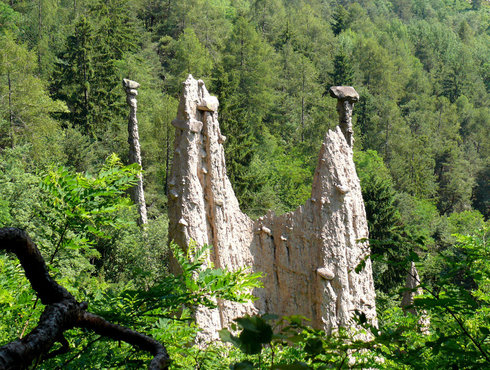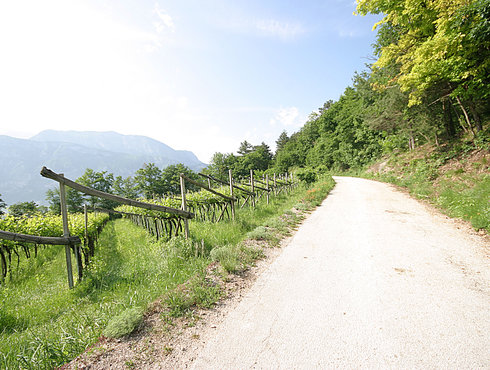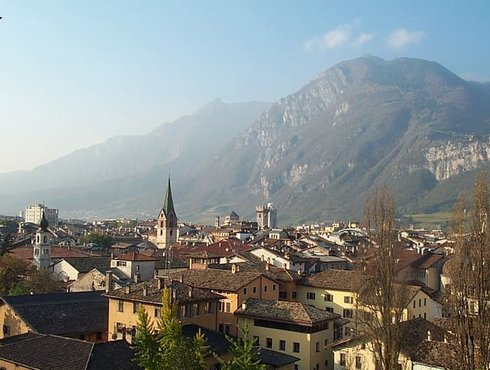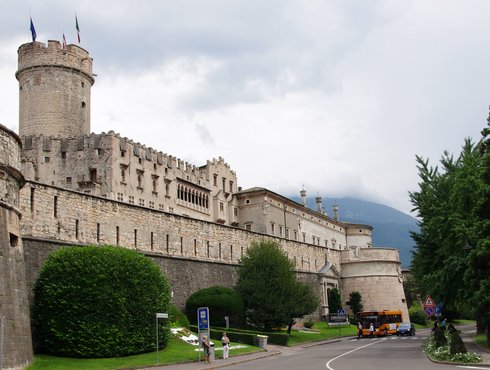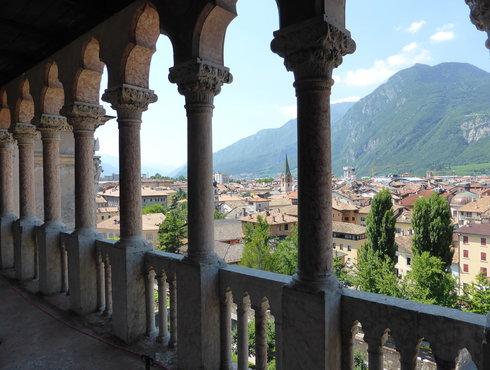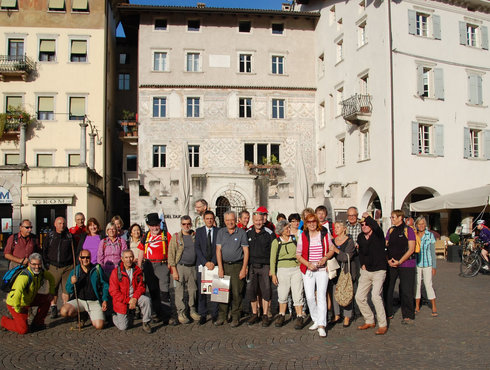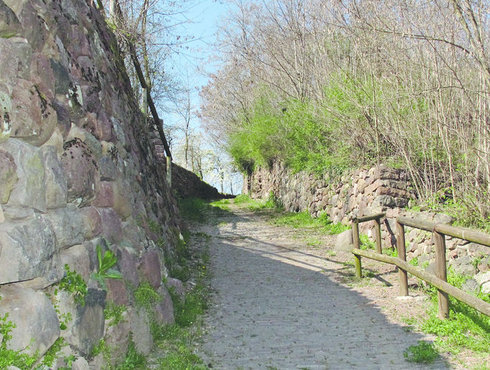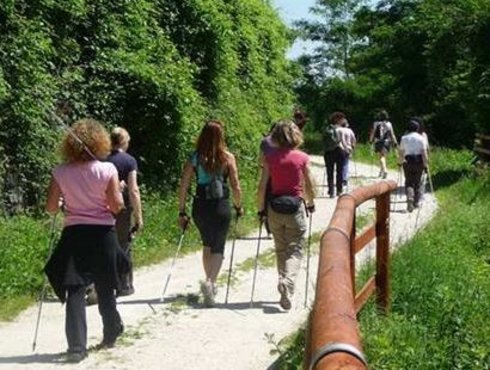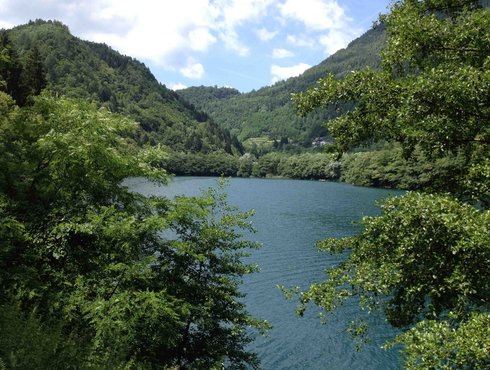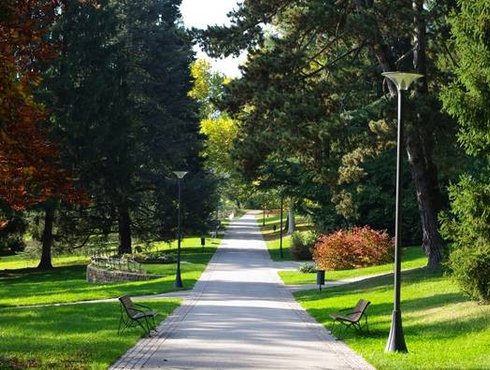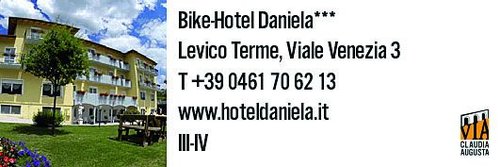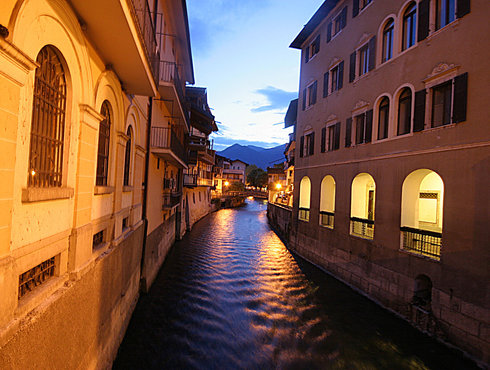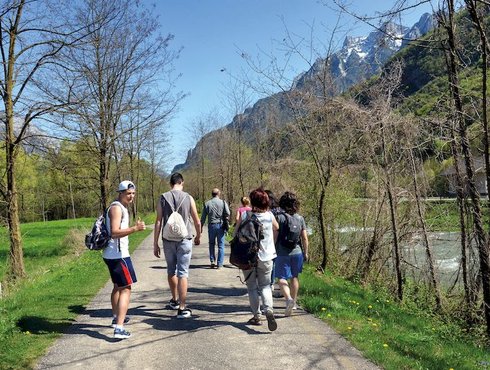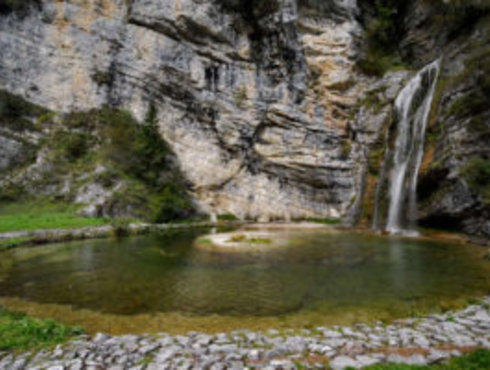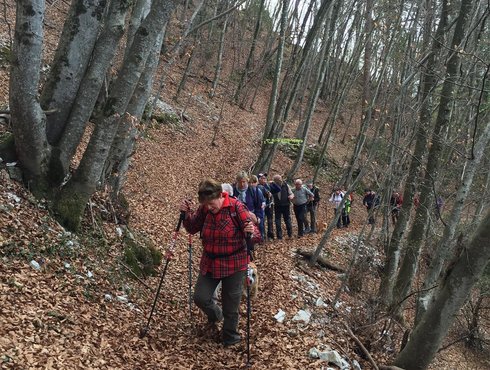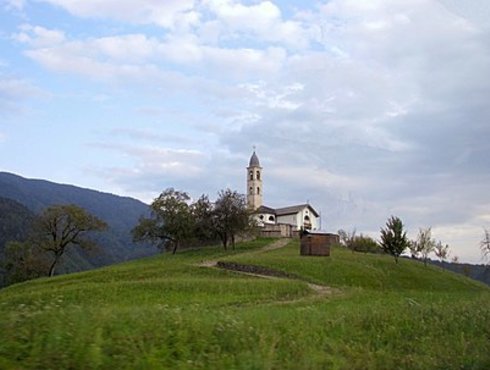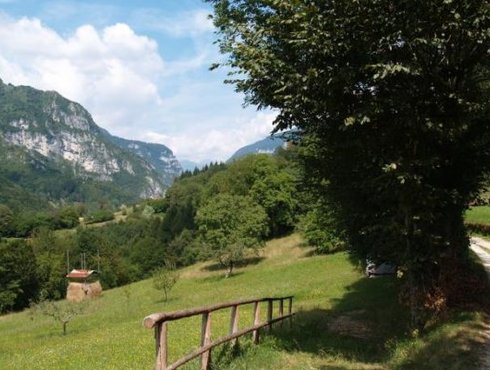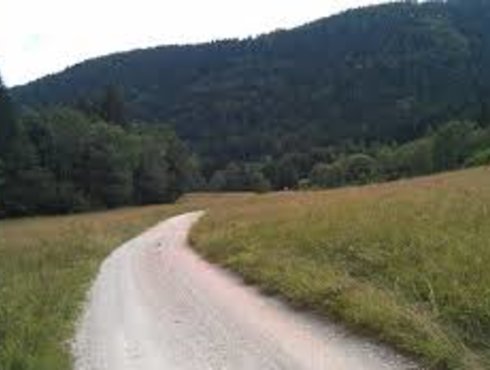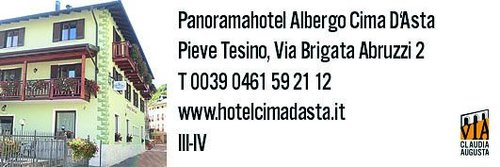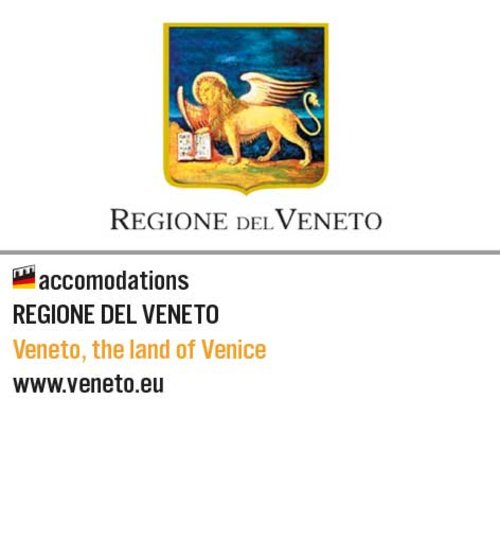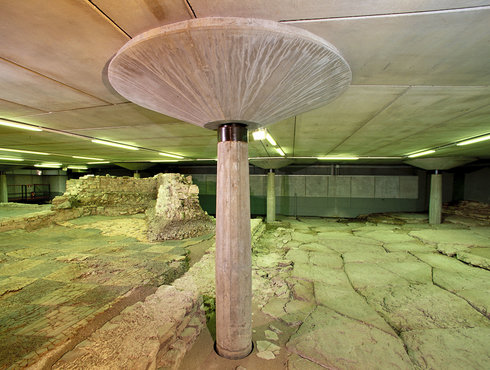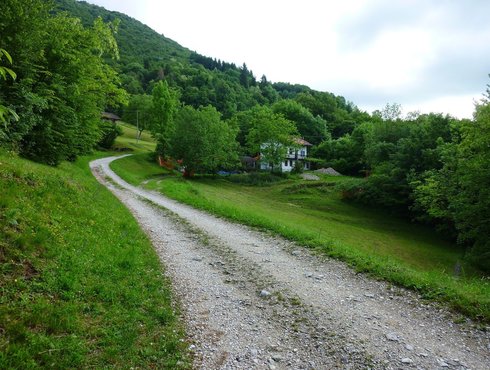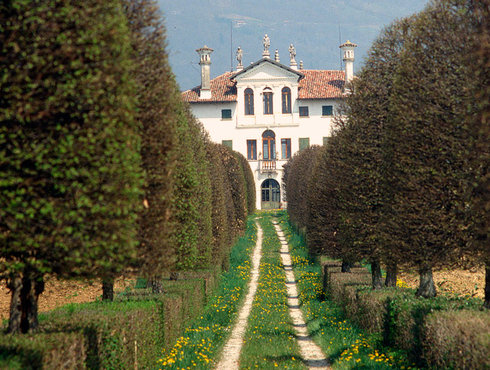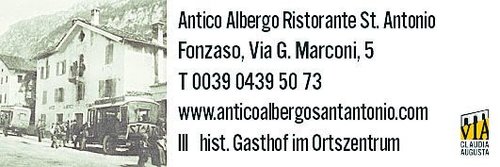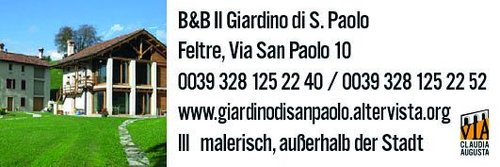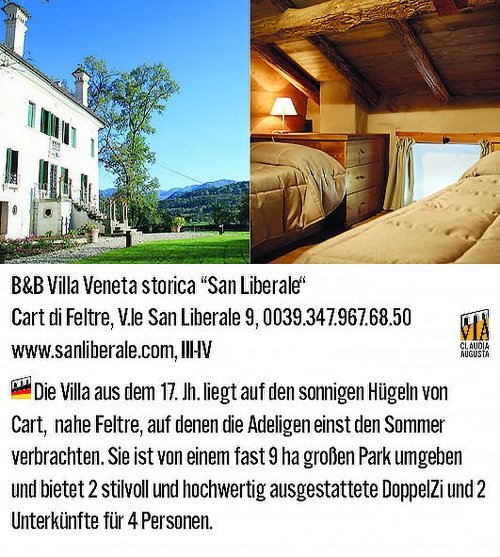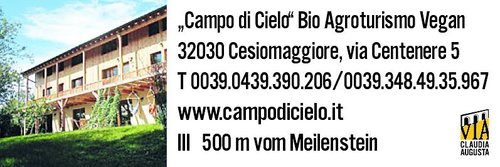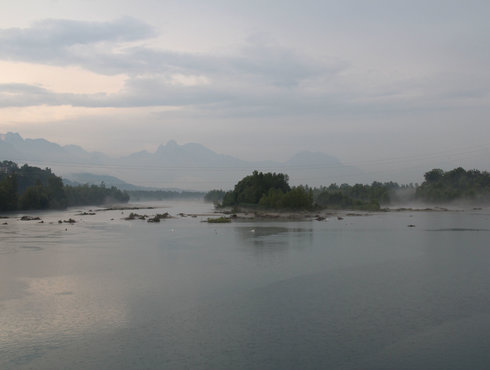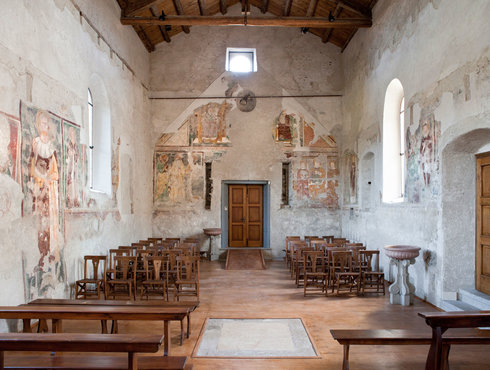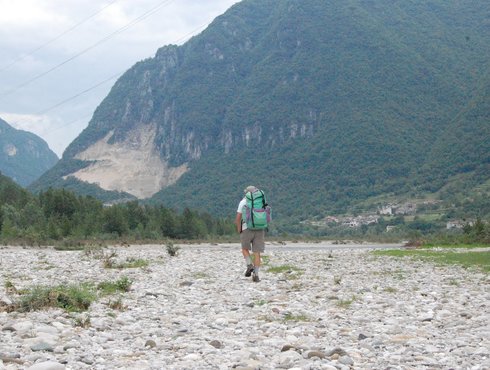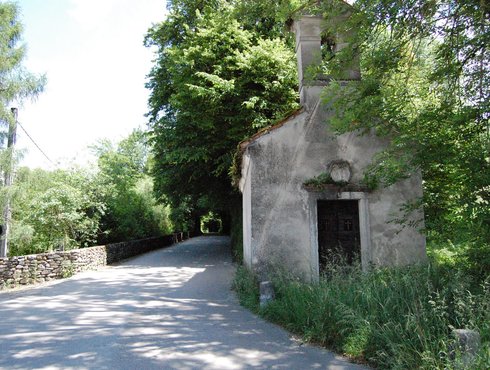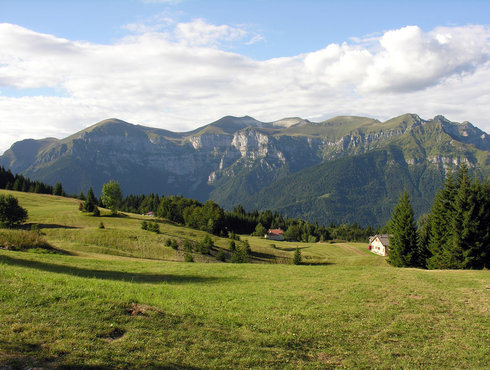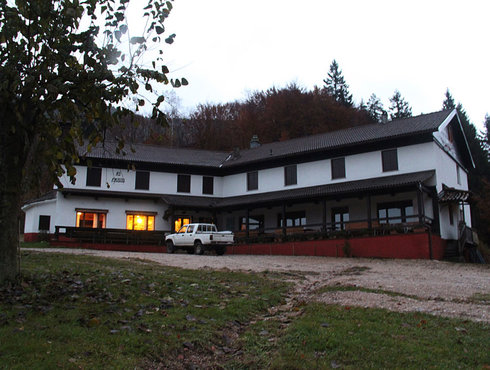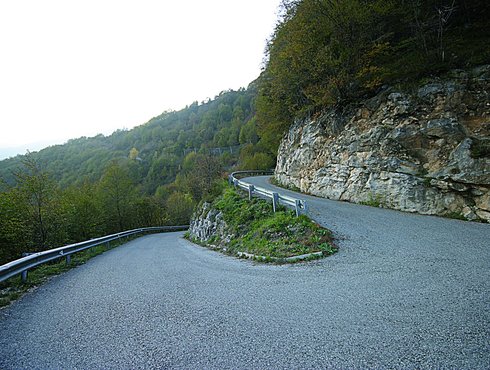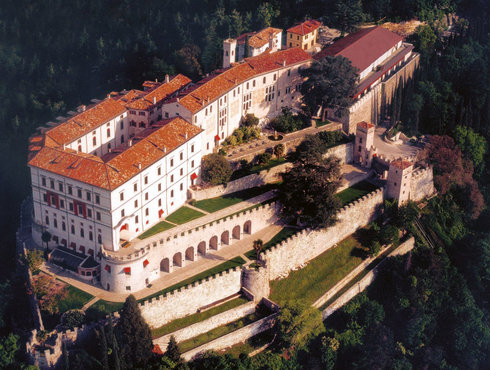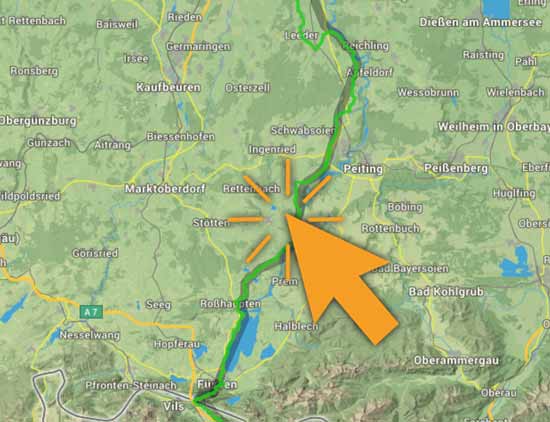The content menu at the start of the route description allows you to jump directly to the various sub-sections. There is currently only one long-distance hiking track along the ‘Altinate’ route. It runs along the northern edge of the Venetian Plain to Castelbrando. You can use the detailed route description for reference during your long-distance hike alongside the hiking maps Bavaria / Tyrol / Reschenpass-Trento / Trento-Castelbrando ,available for download. Alternatively, you can download offline navigation apps for your iPhone or Android or simply take a printed guidebook with you.
Cycle(Tour)
(Long distance)Hiking
Car(Touring)
Holidays & trips
detailed description of the 'Altinate' long-distance hiking route (from Trento to Feltre and Castelbrando)

Virtual Museum
Cultural guide
Virtual journey
Route planner
Historical maps
Tour books
Videos
Climate
Jump to a specific section


The Via Claudia Augusta starts in the town of Donauwörth. This has two reasons: the Danube, which allowed the Romans to transport heavy goods, and the northern border of the Roman Empire, which was located here before and after the first retreat of the Roman Empire from the Germanic tribes. The northernmost part of the Roman road runs through the modern district of Donau-Ries, which nearly reaches the Limes in the north. Apart from the Danube, the area is characterized by the Ries crater. It has a diameter of 25 kilometers and was created by a meteorite 14.5 million years ago. The name ‘Ries’ is said to be derived from the Roman province of Rhaetia. Donauwörth, the town where the Roman road ends, did not exist during Roman times. Instead, the area was frequently flooded by five rivers whose confluence lies in the Donauwörth region: the Danube, Wörnitz, Zusam, Schmutter and Lech. The town began as a fishermen’s settlement on the island of Ried in the Wörnitz river. Today, most of the old town is located to the north of the river. It offers one of Germany’s most beautiful streets, the Reichsstraße.
We recommend that you take a train to the Donauwörth intercity railway station. If you are arriving by car, you can leave your car at the parking lot on Neue Obermayerstraße while you explore the area by bike. Consider arriving a day early so that you can start your long-distance hike well rested and see a little of this lovely town before you set out.
From the railway station, the hiking route takes you across the island of Ried, where the first settlements of Donauwörth were established. You then reach the modern town center with the beautiful Reichsstraße street. Drop into the tourist information office if you still need any guides, maps or other paperwork, then continue across the Danube and southwards.
A shuttle is available to take you back to Donauwörth after your hike . Book online at www.viaclaudia.org. Link
For information, contact
Via Claudia Augusta Info
www.viaclaudia.org
info@viaclaudia.org
0043 664 27 63 555
If you have specific questions about the town of Donauwörth, in particular, contact the
municipal tourist information office of Donauwörth
https://www.donauwoerth.de/tourismus/
Rathausgasse 1
tourist-info@donauwoerth.de
0049 906 78 91 51
For specific questions about the region, contact
the Donau-Ries tourist board
www.ferienland-donau-ries.de
info@ferienland-donau-ries.de
0049 906 74 211




In Roman times, there were already settlements in the estuary region of the rivers Wörnitz, Schmutter and Lech and in the part of the Lechtal valley bordering Augsburg. The inconspicuous little hill between Mertingen and Druisheim was the site of Submuntorium-Burghöfe, a Roman fortress complex. Another military site is said to have stood in Langweid am Lech. The towns up to Drusheim are still part of the district of Donau-Ries. Beyond Drusheim, the district of Augsburg begins. Its largest towns are Meitingen, which gained market privileges in 1989, and Gersthofen, which became a town in 1969. The Roman road follows the Lech towards Augsburg. In some parts, it is still a road. In others, it is a dam on the ground. Most of it is covered by the national road number 2 today. The Roman road runs past the floodplains of the Lech river, which separates the district of Augsburg from the Wittelsbacher Land.
The hiking route takes you to the Lechtal valley from north to south past picturesque meadows and fields. You will be passing many villages small and large on the way. Between Mertingen and Druisheim, an information panel marks the location of the Submuntorium-Burghöfe fortress complex. It was the last building before the Danube, which probably had a very wide riverbed back then. Soon after, you reach Holzen Abbey. From Nordendorf, the hiking route follows the eastern edge of the Lechtal valley before crossing the valley and the river near Gersthofen. In the town center, the balloon museum is well worth a visit. Hike onwards along the Lech to reach Augsburg. The route crosses the river on the Lechhausen Brücke bridge on the way to the old town.
For information, contact
Via Claudia Augusta Info
www.viaclaudia.org
info@viaclaudia.org
0043 664 27 63 555
For specific questions about the region up to Mertingen/Druisheim, contact
the Donau-Ries tourist board
www.ferienland-donau-ries.de
info@ferienland-donau-ries.de
0049 906 74 211
For specific questions about the region from Allmannshofen/Nordendorf onwards, contact
the tourist information office of Regio Augsburg Tourismus GmbH
www.augsburg-tourismus.de
Rathausplatz 1, Augsburg
tourismus@regio-augsburg.de
0049 821 50 207 0




After the Alpine Campaign in 15 B. C., Emperor Augustus’ adoptive sons, Drusus and Tiberius, established a military camp in Oberhausen, a northern district. The camp was the foundation of Augusta Vindelicum, the later capital of the province of Rhaetia. Augsburg is probably Germany’s second oldest city. It was most certainly one of the largest Roman towns north of the Alps. Spanning more than 25 ha, the settlement had up to 15,000 inhabitants in its heyday and offered them everything they would have expected from a Roman provincial capital: a temple, market hall, governor’s palace, theater, spas ... All townhouses had running water. The Via Claudia Augusta passed the town to the west. In the central area between the town hall and the Mercury fountain, it is identical to the historical main road through the old town. Augsburg rose to even greater significance in the late Middle Ages and the beginning of the modern era, when the rich Fugger family established their global business empire from here. Later, the prince-bishops of Augsburg reigned over a vast expanse of land that stretched all the way to Tyrol.
Cross the Lechhausen Brücke bridge to get from the Lech to the city. Head along Lechhauser Straße, Jakoberstraße, Barfüßerstraße, Metzgplatz and Am Perlachberg (1.5 km) to reach the Rathausplatz (the central town hall square) with the Perlachturm tower and the ceremonial Goldener Saal and gain an impression of the old and new town on the way.
A guided tour in a taxi is the most comfortable way to travel through time: up to four people pay EUR 29 per hour. Augsburg’s sights are all in close proximity to each other, however, so you can easily see them on foot. We start at the former prince-bishops’ residence (Fürstbischöfliche Residenz), whose inhabitants controlled the fate of the surrounding region up to Tyrol for a long time. Today, it is the seat of the Swabian regional government. From here, the route leads you around the cathedral and to the garden on Äußeres Pfaffengässchen, where you can catch an archaeological glimpse of Roman Augsburg. In 2014, the Fugger und Welser Erlebnismuseum opened a Renaissance garden house with an interactive multimedia exhibition about the significance of Augsburg and the economical influence of its mercantile families on Europe and the world in the 16th century. After visiting the cathedral, have a look at the stone sculptures on the Roman wall on the southern cathedral square. On the opposite side of the street, at Peutingerstraße 11, you can see the house of the humanist Konrad Peutinger. The merchant, who collected Roman coins and stone monuments, is the father of Roman research in Augsburg. He also gave his name to the first world map of Roman roads, whose 12th-century copy he sought to publish. At the gate of his house, Roman and Jewish stone monuments have been fixed in the wall. The next stop on your route is the town hall, one of the most important secular Renaissance buildings north of the Alps. Alongside the Perlachturm tower, which offers wonderful views of the city, it is the symbol of Augsburg. The Goldener Saal inside the town hall is one of Germany’s most significant cultural monuments from the Late Renaissance. Perched atop the monumental fountain, Emperor Augustus watches over the city he founded. On the stretch between the town hall and the Mercury fountain to the south, the Maximilianstraße is identical to the Roman road running past the city to the west. Head a little further west still to reach the Maximilianmuseum at Fuggerplatz 1. It is the storehouse of the city’s art galleries and museums and contains three separate sections: sculptures, handicrafts, local history. Among its most fascinating treasures is a collection of sculptures from the Late Renaissance and goldworks from the era when the Fuggers’ city was one of Central Europe’s main centers of goldsmithing. But the greatest attraction of the museum is the Viermetzhof, its glass-covered inner courtyard. It showcases the restored figures of Augsburg’s monumental fountains, the Augustus fountain, Hercules fountain and Mercury fountain. A little further along the road, at Zeugplatz 4, you can see the Baroque armory, which was also used as military barracks. Of course, the Fuggers also had their palace on Maximilanstraße (building 36). On the way back, you pass the Fuggerei, their social housing complex.
Head south from the Rathausplatz and along Maximilianstraße (or ‘Max-Straße’, as the people of Augsburg lovingly call their historic street). It leads up to the Ulrichskirche church. Continue out of the city center and to the Siebentisch-Wald forest on the Lech river, a local recreation area popular among the residents of Augsburg. Follow the hiking route to the south.
For information, contact
Via Claudia Augusta Info
www.viaclaudia.org
info@viaclaudia.org
0043 664 27 63 555
For specific questions about the region, contact
the tourist information office of Regio Augsburg Tourismus GmbH
www.augsburg-tourismus.de
Rathausplatz 1, Augsburg
tourismus@regio-augsburg.de
0049 821 50 207 0


The Lechfeld is a strikingly flat gravel plain that gained tragic fame after the Battle of Lechfeld against Hungary in 955. There were already settlements here in Roman times. Historians believe that the Roman road station Ad Novas, marked on the ancient road map Tabula Peutingeriana, was located in Igling. Another fortress from the Late Roman Empire is believed to have stood in Untermeitingen. In the south, Augsburg borders the relatively new town of Königsbrunn, where you can visit a Temple of Mithras. Recent settlement of the area only occurred in the early 19th century. Like the towns up to Obermeitingen, Königsbrunn is part of the district of Augsburg. It borders the district of Landsberg am Lech to the south. From the Lechfeld, you can clearly see long sections of the Roman road, which runs steadily towards the Alps. The hiking route takes you through picturesque towns along the old country road. Graben is the home town of Hans Fugger.
Cross the Siebentisch-Wald forest on the Lech, a local recreational area that is popular with the people of Augsburg. Continue to Haunstetten and Königsbrunn, where the hiking route runs into the town center near the Ilsesee, another local recreational area with a lake. The route through Königsbrunn, the Lechfeld and its villages mostly follows the old Roman road. In Klosterlechfeld, the hiking route crosses the river and leads you to Kaufering and Landsberg am Lech.
For information, contact
Via Claudia Augusta Info
www.viaclaudia.org
info@viaclaudia.org
0043 664 27 63 555
For specific questions about the region up to Untermeitingen/Klosterlechfeld, contact
the tourist information office of Regio Augsburg Tourismus GmbH
www.augsburg-tourismus.de
Rathausplatz 1, Augsburg
tourismus@regio-augsburg.de
0049 821 50 207 0
For specific questions about the region from Scheuring/Obermeitingen/Kaufering onwards, contact
the tourist information office of Landsberg am Lech/Ammersee-Lech
https://www.landsberg.de/tourismus/
Hauptplatz 152, 86899 Landsberg am Lech
kontakt@landsberg.de
0049 8191 128 246




The important salt road from Reichenhall to Munich crossed the Via Claudia Augusta here on its way to Switzerland. Duke Henry the Lion moved it a little way to the south from Kaufering in 1158. During that project, he had a bridge built and expanded the existing castle to protect it. The new complex was called the Castrum Landespurch. Nestled between the Lech and its high banks and overlooked by the castle, a settlement sprang up and grew rapidly. It would become the town of Landsberg in the 13th century. Today, the town to the west of the Lech is considerably larger, and its modern urban area dates back to the 19th century. The Via Claudia Augusta crossed some of the municipality westwards. Just like the river, it played an important role in the economic development of the town. The medieval old town is only accessible via the bridge over the Lech or its gates. It still retains some of its repeatedly expanded medieval walls. A recently redesigned main square is the town’s greatest attraction.
Near Klosterlechfeld, the Via Claudia Augusta hiking route crosses the river and follows its course along picturesque meadows and forests. It first leads you through the eastern part of Kaufering before heading to Landsberg am Lech. Hikers catch their first glimpse of the medieval town from the high banks of the river. Following the former salt road, you will pass through the Sandauertor gate to reach the picturesque and historical main square, which was redesigned and revived very recently. Take a little break and enjoy the shops, cafés, and ice cream parlors that line the square. Today, the bridge over the Lech in Lechwehr is in the exact same spot where the salt road used to cross the river. The hiking route sticks to the eastern bank of the Lech as it leaves the town through the gate of the former waterhouse. Pöring and Pitzling to the south are parts of the municipality of Landsberg, but the surrounding nature gives the area a genuine countryside feeling.
For information, contact
Via Claudia Augusta Info
www.viaclaudia.org
info@viaclaudia.org
0043 664 27 63 555
For specific questions about the region, contact
the tourist information office of Landsberg am Lech/Ammersee-Lech
https://www.landsberg.de/tourismus/
Hauptplatz 152, 86899 Landsberg am Lech
kontakt@landsberg.de
0049 8191 128 246




Between Landsberg and Schongau, the route leads crosses the Fuchstal valley to Epfach, the Roman Abodiacum before following the high banks of the Lech to Kinsau, Hohenfurch and Altenstadt, the mother parish of Schongau. Fuchstal is the valley of the Wiesbach river, a tributary of the Lech. It sits between the high banks of the Lech and a forested ridge to the west, next to the towns of Unterdießen, Asch, Leeder and Denklingen. ‘Fuchs’ is German for ‘fox’: the valley is said to be named for the brown color of its fields in fall. Just before Hohenfurch in the district of Weilheim-Schongau, you will climb the first hills since Donau-Ries. The villages in this section are particularly pretty and traditional. History enthusiasts will doubtlessly enjoy a visit to the site of the former Roman fortress of Abodiacum on the Lorenzberg, situated on a peninsula in the riverbend near Epfach.
The section follows the high bank of the Lech, crossing from the east to the west bank after a while. It then continues to the Schongau area. Romantic forests, idyllic meadows and many spectacular views of the Lech will keep you entertained on your way from Landsberg to Mundraching and Reichling. Near Epfach, the former site of a Roman fortress and the regional capital during Roman times, the track crosses the Lech. You have reached the home of the most famous Bavarian of the Roman Empire: Claudius Paternus Clementianus, governor of Noricum. Its attractions include the Lorenzberg, a Roman nymphaeum, and the little Roman Abodiacum museum, which tells the story of the military site on the Lorenzberg. Continue to follow the high bank of the Lech to Kinsau and admire its terrace-shaped layout from the road. Crossing picturesque meadows far above the Lech, the route takes you to Hohenfurch and Schongau.
For information, contact
Via Claudia Augusta Info
www.viaclaudia.org
info@viaclaudia.org
0043 664 27 63 555
For specific questions about the region up to Reichling/Epfach, contact
the tourist information office of Landsberg am Lech/Ammersee-Lech
Hauptplatz 152, 86899 Landsberg am Lech
kontakt@landsberg.de
0049 8191 128 246
For specific questions about the region from Kinsau onwards, contact
the Pfaffenwinkel tourist board
www.pfaffen-winkel.de
Bauerngasse 5, 86956 Schongau
info@pfaffen-winkel.de
0049 8861 21 13 00


During Roman times, another Roman road crossed the Alps via Garmisch and the Brennerpass. It was also called the Via Claudia, but it was not yet ‘Augusta’ (=imperial). In the Middle Ages, the roads that remained in use were dubbed the Upper Road and Lower Road. Their crossroads was an excellent spot to do business during Roman times and beyond. In Peiting to the east of the Lech, a Villa Rustica documents the outstanding domestic culture of the Romans. The town of Schongau, which was moved to the safer hill from its mother parish of Altenstadt in the 13th century, also flourished thanks to the nearby traffic hub. In 1331, the town was even granted the right to mint and issue its own coins. The old town has retained its entire town walls and can only be accessed through its gates. A large number of religious buildings also bear testimony to wealth of this region, which is called Pfaffenwinkel. Schongau and Peiting are considered its gateway. Wieskirche Pilgrimage Church is its best-known sacred building and a UNESCO World Heritage Site.
Although our hiking route does not cross Altenstadt, we will take a brief detour there: Altenstadt is the Roman predecessor and mother parish of Schongau. Its Romanesque domed basilica grants you a glimpse into its rich history. The hiking route continues straight to Schongau, crossing picturesque meadows and romantic forests on the way. In the town area, it follows the beautiful riverbends of the Lech, where the people of Schongau love to spend time. The old town is on the way. Situated at a slightly elevated position, it overlooks the Lech and is surrounded entirely by its medieval walls. The town itself can only be accessed through the gates. On the other side of the Lech, to the south of the market town of Peiting, you can see the partial excavation of an extended country manor: Peiting’s Villa Rustica. To visit it, head through the center of Schongau and cross the dam as you exit. Return to the hiking route over the striking bridge. Altenstadt, Schongau and Peiting have been situated at an important crossroads ever since Roman times. In the Roman era, the Roman road ran past Scharnitz and Garmisch to cross the Via Claudia Augusta here. Later, in the Middle Ages, the two roads remained in use and were called Upper Road and Lower Road.
For information, contact
Via Claudia Augusta Info
www.viaclaudia.org
info@viaclaudia.org
0043 664 27 63 555
For specific questions about the town of Schongau, contact the
Schongau tourist information office.
www.schongau.de
Münzstraße 1 - 3, 86956 Schongau
touristinfo@schongau.de
0049 8161 214 181
For specific questions about the region , contact
the Pfaffenwinkel tourist board
www.pfaffen-winkel.de
Bauerngasse 5, 86956 Schongau
info@pfaffen-winkel.de
0049 8861 21 13 00


The Auerbergland: lands around a foothill that has seen settlements for millennia
- 08
The municipalities in the Alpine foothills around the Auerberg initiated the initiative to revive the entire length of the Via Claudia Augusta. In this region, the Auerbergland, there are particularly many visible sections of the old Roman road. Its inhabitants have come up with many interesting ways of drawing attention to this important part of their heritage. There are quite a few historical highlights here: the site of millennia-old settlements around the Auerberg, the rafters’ village of Lechbruck am See, the Bavarian Via Claudia Augusta info center, and the Forggensee boat tour that follows the Roman road are well worth your time. Verdant hills and forests punctuated by lakes and set against a spectacular Alpine backdrop make the region a nature lover’s paradise. Its pretty holiday destinations have retained their authentic village atmosphere. The Roman road mostly followed the Lech through the Auerbergland. Some parts crossed the river in the area where it was dammed to create the Forggensee lake.
Soon after Schongau, the hiking route crosses an extensive forest before rejoining the historical Roman route and continuing to follow it through the Auerbergland between Schongau and Füssen. Near Burggen, you are treated to one of the most spectacular views of the river: the ‘Litzauer Schleifen’. Afterwards, the route takes you up the Auerberg, which was the site of human settlements as early as pre-Roman times and the Roman era. Visit the Auerbergmuseum in Bernbeuren on the way to learn more about the history of this Alpine foothill. Then continue to the rafters’ village of Lechbruck, which has developed into a popular holiday destination – not just for the Lechsee, a reservoir of the river. On your journey through the Auerbergland along the Via Claudia Augusta, you will enjoy the exact landscapes for which the Allgäu is famous: gently rolling hills covered in verdant pastures, fairytale forests and plenty of lakes and ponds of all sizes. You will pass some of them on the way from Lechbruck to Rosshaupten, where the Bavarian Via Claudia Augusta documentation center is located. The Via Claudia Augusta Kunstpark, an open-air art exhibition, is also en route. Past Rieden and Füssen, the hiking route returns to the shore of the Forggensee lake. Unfortunately, the Direttissima route, which once followed the Roman road, is no longer usable today: the Roman road is submerged in the reservoir and can only be accessed during a few weeks every year, when the water level is lowered to generate electricity in the off season.
For information, contact
Via Claudia Augusta Info
www.viaclaudia.org
info@viaclaudia.org
0043 664 27 63 555
For specific questions about the entire Pfaffenwinkel region up to Bernbeuren, contact the
Pfaffenwinkel tourist board
www.pfaffen-winkel.de
Bauerngasse 5, 86956 Schongau
info@pfaffen-winkel.de
0049 8861 21 13 00
For specific questions about Bernbeuren and the Auerberg, contact the
tourist board of Bernbeuren am Auerberg
bernbeuren.de/informationen.0.html
Marktplatz 4, 86975 Bernbeuren
info@bernbeuren.de
0049 8860 210
For specific questions about Lechbruck, contact the
tourist information office of Lechbruck am See
www.lechbruck.de
Flößerstraße 1, 86983 Lechbruck am See
info@lechbruck.de
0049 8862 987 830
For specific questions about Rosshaupten, contact the Rosshaupten
tourist information office
www.rosshaupten.de
Hauptstraße 10, 87672 Rosshaupten
info@rosshaupten.de
0049 8867 364
For specific questions about Rieden am Forggensee , contact the
tourist information office of Rieden am Forggensee
www.rieden.de
Lindenweg 4, 87669 Rieden am Forggensee
info@rieden.de
0049 8362 37025




The beautiful stretch of land where the Lech exits the Alps has been inhabited since Roman times. A Roman fortress used to stand on the Füssen’s castle hill. The Via Claudia Augusta passed beneath it. The Reichenstraße, the modern promenade in the old town, corresponds exactly to the route of the Roman road. At the valley station of the Tegelberg Cable Car, remnants of a private spa from a Villa Rustica grant us a glimpse into upper-class domestic life during the Roman Empire. The foundation of medieval Füssen and its long violin-making tradition date back to Saint Magnus of Füssen, who settled here as a religious hermit in the 8th century. In the 9th century, a Benedictine monastery was founded on the spot where his cell used to stand and named after him: St. Mang’s Abbey. Later, the people of Wittelsbach and Ludwig II of Bavaria discovered the spectacular natural landscape of the Alpine foothills, and the latter decided to build his fairytale castles here. You are standing in Schwangau, where guests of the Königliche Kristall-Therme spa get to unwind and let themselves be pampered just like the Romans used to do.
The hiking route now takes you along the shore of the Forggensee lake to the festival hall and the old town of Füssen, where a Roman fortress used to stand on the castle hill. Following the eastern bank of the Lech, the route takes you into the old town. Its historical main road, the Reichenstraße, is identical to the route of the Roman road. It is a pedestrian area today. To visit Schwangau and the royal castles, head out from the Lechbrücke bridge to the east of Füssen. Afterwards, return on the same path or take the Fürstenweg to the town of Pinswang in Tyrol. Leaving Füssen, you will follow the left side of the river to the Lechfall, where the water roars out of the Alps. Cross the bridge over the falls and enjoy the spectacular views. On your way to Tyrol, you get a chance to visit the Füssen Forest Experience Center and a treetop path giving you sweeping bird’s-eye views of the alluvial forests.
For information, contact
Via Claudia Augusta Info
www.viaclaudia.org
info@viaclaudia.org
0043 664 27 63 555
For specific questions about the town of Füssen, contact the
tourist information office of Füssen Tourismus und Marketing.
www.fuessen.de
Kaiser-Maximilian-Platz 1, 87629 Füssen
tourismus@fuessen.de
0049 8362 93 850
For specific questions about the town of Schwangau , contact the
Schwangau tourist information office.
Münchner Straße 3
info@schwangau.de
0049 8362 81 980








Text of the historical map of ...
100 AD
Gateway to the Alps
The Roman road entered the Alps as if through a gateway. As the Lech often occupied the entire valley, it already had to overcome two elevations up to the Reutte valley basin – between Stiglberg and Kratzer and at the Kniepass. The route of the Roman road remained in use until 1784 and the modern road still crosses the Kniepass today. Before climbing to Ehrenberg, the Via Claudia Augusta passed through the municipality of Breitenwang, where a road station (mansio) and the fifirst small settlement in the valley basin are thought to have been located. Reutte developed at a later stage – on the salt road. Breitenwang still remains the district’s ecclesiastic centre today.
1504
Reutte flourishes
With its extensive floodplains, the Lech also shaped the valley basin back in 1504 that depended significantly for its livelihood on the salt road between Hall in Tirol and the Lake Constance area. A bridge was built in 1464 between Lechaschau and Reutte that replaced the Lech ford near Höfen. With its salt depot and numerous roadside inns, Reutte grew into the centre of the Ausserfern district and in 1489 it was granted market rights by Sigesmund “the Rich”. Ehrenberg Castle throned above the valley. A wall blocked the gorge and all traffic had to pass through the customs station gate. There was an ironworks near Pflach. Vils, not yet part of Tyrol, was a town since 1327 and enclosed by a wall with two gates in the north and south.
1780
strongly fortified
Numerous fortifications in the border area between Bavaria and Tyrol shaped the area around 1780. In addition to the dam at Ehrenberg that had grown around two further fortresses, there were several outer fortresses. The market town of Reutte at their feet already had around 1,000 inhabitants and several new roads were completed. The road from Reutte via Vils to Kempten now passed by the walled city to the south, while that from Füssen to Pinswang went around the Stiglberg. The Ulrichs-brücke bridge was not constructed until 1914. Shortly after the turn of the century, the existing Bavarian local railway was also extended to join the Ausserfern railway that initially went to Reutte. The river was largely unregulated even around Reutte.


The first mountain ridges at the border between Germany and Austria form a gate, which the Via Claudia Augusta crossed into the Alps and the Reutte nature reserve region in Tyrol. This is where the only untouched section of the Lech in the northern Alps begins. The realm of the ‘last wild one’, as the nature park exhibition dubs the river, is dominated by extensive gravel banks and wetlands that cover the entire valley in some sections. Since time immemorial, the river has determined where settlements and roads could be built. Large parts of the valley have always been prone to flooding, so the Roman route of the Via Claudia Augusta crossed two plateaus between Füssen and the valley basin of Reutte: the mountain ridge between the Stiglberg and Kratzer and the Kniepass.
Leave the old town of Füssen and cross the Lech river. Make sure you look back at the town from the south bank of the river: the view is wonderful! As you enter Austria, the hiking route runs parallel to the Lech river and the picturesque, old country road, parts of which are lined with trees. After Pinswang, the route runs over the mountain ridge between Stiglberg and Kratzer in the same spot where the Roman road is believed to have crossed it. Continue through the picturesque villages of Unterpinswang and Oberpinswang before crossing the Kniepass. Having visited Breitenwang and Reutte, you will cross the Mösle (a forested wetland) and the Urisee, a popular swimming lake.
For information, contact
Via Claudia Augusta Info
info@viaclaudia.org
0043 664 27 63 555
For specific questions about the region, contact the
tourist board of the Reutte nature reserve region.
Untermarkt 34
info@reutte.com
0043 5672 62336 40


In the valley basin of Reutte, the Via Claudia Augusta led through Breitenwang towards Ehrenberg. It is believed that the town had a Roman road station just before the ascent. Around 1464, when the salt road from Hall in Tirol to the region around Lake Constance was relatively new, the Roman road was moved to Reutte, and the market town developed into a regional center. Many Roman buildings have survived to this day. Characteristic architectural artworks adorn the facades of the houses in Reutte; many of them were painted by the Zeiler family of artists. The fortress complex of Ehrenberg is located to the south of Reutte. Its four towering fortresses used to constitute a barrage against Bavaria. The complex even had outer baileys between Pflach and Pinswang/Musau, where the border used to be. Vils was a walled Bavarian town.
Coming from Breitenwang, the hiking route runs directly into the center of the market town of Reutte. The roundabout constitutes the border between the Untermarkt (lower market) and Obermarkt (upper market). The road through the Obermarkt corresponds to the salt road, which crossed the Lech between Lechaschau and Reutte. Do not miss the turns leading towards the hospital and, a little later, to Ehrenberg. The relatively steep gravel path up to the Burgenwelt Ehrenberg (the Ehrenberg castle ensemble) also corresponds to the salt road. You can still see parts of the steadily ascending Roman road on the right and left.
For information, contact
Via Claudia Augusta Info
info@viaclaudia.org
0043 664 27 63 555
For specific questions about the region, contact the
tourist board of the Reutte nature reserve region.
Untermarkt 34
info@reutte.com
0043 5672 62336 40






Text of the historical map of ...
400 AD
Masterful roads
The aim of the Roman road builders was to construct the quickest route from the Adriatic and the Po to the limes. Even in Tirol the Via Claudia Augusta therefore only has four hairpin bends. Nevertheless, the ffiirst trans-European road has a relatively constant incline even over the challenging sections across the passes. Another outstanding feat is the section on 1,000 tree trunks across the ‘Moos’ wetland habitat between Lermoos, Ehrwald and Biberwier, near to which two settlements were located – one in Ehrwald that already existed before the arrival of the Romans and continued to exist during the Roman era, and one founded by the Romans in the area surrounding the road station in Biberwier, immediately in front of the Fern Pass.
1599
Living from the road
While the Roman road was sustained by the fiffiirst European single market with no customs or tolls, the era of the salt road was shaped by the transport of goods. The local residents had the exclusive privilege of transporting certain goods such as salt from one place to the next. The population along the route benefiffiited from both of these systems. The population of Zwischentoren, the area between the Ehrenberg and Fernstein gates, is thought only to have become properly aware of this when the Arlberg Pass was made navigable again. As the traffiffiic shifted away, they became desperately poor. After meeting to say farewell at Austria’s only guild church in Bichlbach, many people from the Ausserfern district were forced to move as building workers to the neighbouring regions to the north. Children also moved away as ‘Swabian children’.
1926
Further development
A new wave of development started in the second half of the nineteenth century from Zwischentoren, the area between the two gates of Ehrenberg and Fernstein through which the Fern Pass road passed until 1856. It was then that today’s road was built. In 1913 the Ausserfern railway was extended that had previously terminated in Reutte. As an alternative to the completed route via Garmisch and on to Innsbruck, there was also talk of a line across the Gaistal, Leutasch and Seefeld. Furthermore, there were plans for a rail link to Imst with a summit tunnel through the Fern Pass of the sort currently being planned for cars. The Tyrolean Zugspitze Railway was one of the fiffiirst mountain railways and promot


From Heiterwang onwards, the landscape becomes more alpine. You can easily tell that it is covered in snow for longer stretches of the spring. This may be a blessing for holidaymakers, but it has always brought hard work and meager harvests to the farmers of the region. The area between the two gates of Ehrenberg and Fernstein is called ‘Zwischentoren’ (literally: between gates). Its people have depended on the road for a long time. Many operated small farms to grow their own food while also offering haulage and other services to passersby to make a living. The slopes of the mountains were mowed up to the peaks in order to feed the local animals and those of travelers. Between Heiterwang and Bichlbach , you can still see these slopes today. When the road over the Arlberg Pass and, later, the Arlberg railway were built, the road suddenly lost its status as an important thoroughfare, plunging the people of the road into bitter poverty. Many were forced to leave their home region to seek manual work elsewhere. The children who left the Alps for Swabia came to be known as ‘Swabian children’.
Just like the Roman route and the salt road, our hiking route runs through the gate of the Klause Ehrenberg fortress. For many centuries, this was the only way of crossing the reservoir, where carters had to pay a toll. The route then continues along forest trails to Heiterwang am See, taking you through the Klausenwald forest. You will be following the old Roman road all the way to the edge of the town. The salt road will lead you through the town itself in a wide circle. The hiking route continues towards the Heiterwanger See lake, then follows the Panoramaweg road until the valley basin between Lermoos, Ehrwald and Biberwier. Situated at a slight elevation above the valley, the Panoramaweg offers stunning views of the ‘Mähberg’ mountain, which used to be mowed until the late 20th century, the villages of Bichlbach, Wengle and Lähn, and the original track of the Roman road, which connected them.




Once you enter Lermoos, you will know exactly why the region is called the Tyrolean Zugspitz Arena. The picturesque Moos wetland, which used to carry the Via Claudia Augusta on thousands of logs, is the ring of the arena. The quirky holiday destinations of Ehrwald, Lermoos and Biberwier sit on the box seats surrounding it. The spectacular mountains surrounding Lermoos are the stands. Among them towers the Zugspitze, Germany’s highest mountain. Since 1926, the Tyrolean Zugspitze Cable Car has transported passengers from Ehrwald to the summit. After the old road paled into insignificance, the construction of the cable car became a symbol of a new, brighter economic future for Zwischentoren in the tourism industry.
At the edge of Lermoos, the hiking route departs from the slope of the mountain. It runs through the center of Lermoos, then follows the old Roman road through the picturesque Moos wetland that stretches between the three towns. You can take a detour to Ehrwald and the Zugspitze on the way. A transparent panorama panel near the road shows you how the Roman log road crossed the wetland to Biberwier. In Biberwier, you will pass the location of a Roman road station that was unearthed by archaeologists a few years ago. Having crossed the quaint little town, you start the ascent to the Fernpass.






historical map of ...
100 AD
Old settlement area
There is documentary evidence of “Oppidum Humiste” dating back to 763. Oppidum was a fortifified pre-Roman settlement. Its mention after the Roman era points towards continuous settlement since pre-Roman times that will have been concentrated on the hill above Imst town centre. There are also indications of prehistoric settlement in Dormitz near Nassereith. The Romans established road stations in both places along the Via Claudia Augusta, around which settlements developed. In Imst, which was the most important settlement between Füssen and Merano, this was probably parallel to the pre-Roman settlement. There was also prehistoric and Roman settlement on the sunny slopes of the Tschirgant, in Karrösten and Karres.
1550
Mining stronghold
The area around the Via Claudia Augusta between Biberwier and the Inn Valley was an important mining centre in multiple respects. Signifificant historic mining districts were located in the Mieming mountain range in the east, the Lechtal Alps in the north and on the slopes of the Tschirgant in the south. Numerous tunnel entrances await discovery on close examination particularly in the Wannig rock face above Nassereith. Above all lead was mined as a grey ore for silver mining in Schwaz and Zink. Furthermore, Imst, alongside its importance as a market place and traffic hub, was the seat of the mining court covering an area that reached to the Ausserfern district and Vorarlberg.
1901
Long prevented town
Imst has for thousands of years been the most important settlement between Füssen and Merano and an important traffiffiific hub. It has had market rights since late medieval times and from the fifteenth to the seventeenth centuries it was the seat of a mining court covering an area that reached to the Ausserfern district and Vorarlberg. Had the infflluential lords of Starkenberg not opposed this because Imst would then have been directly subordinate to the territorial prince, the Gurgltal metropolis would have been a town with its own walls for 700 years. Following a ffiire in 1822 to which 206 out of 220 houses fell victim, Imst was rebuilt and ffiinally received town rights in 1898. Imst is also renowned for its bird breeders and dealers.


The Fernpass is the site of a landslide which blocked passage through the area about 4000 years ago. Nature arduously reclaimed the landscape over time. Even today, the topsoil is still thin, and the vegetation reflects that: despite the relatively low altitude of the pass (1216 meters today, 1260 in Roman times), you will spot high-alpine plants here. Paths and roads from the pre-Roman and Roman era, the early modern period, the 19th century and today criss-cross the fascinating landscape. Plans for a tunnel are being discussed. The Roman Via Claudia Augusta ran from Biberwier to the old top of the Fernpass in a straight line. Its route is mostly identical with that of the power line in this area. From the highest point of the pass, the road steadily descended down the slope to the Samerangersee lake. In the late Middle Ages, the Fernpass road was rerouted to cross the top of the Fernpass we know today.
Mostly following the Roman road, the hiking route climbs up to the ‘old top of the Fernpass’ through the seemingly high-alpine forests of the landslide site. It leads directly past the Weissensee lake. The Blindsee is another nearby lake and a popular, Alpine swimming destination. When you reach the Roman top of the Fernpass, take some time to soak up the spectacular, panoramic views of the landscape with all its roads and paths from the pre-Roman era, the Roman Empire, the Middle Ages, and the early modern period. The hiking route descends towards the valley on the Nassereither Almweg, much like the Roman road used to. Having crossed the modern incarnation of the Via Claudia Augusta, the Fernpass national road, it follows long stretches of the Gurglbach river, then crosses the national road again to reach two lakes: the Sammeranger See and the Fernsteinsee lakes. Walk past their beautiful shores to reach the Schloss Fernstein Castle Ensemble.


The Gurgltal valley is an idyllic landscape that is popular with local and foreign leisure-seekers alike. Humans settled in the picturesque valley at a very early stage. Historians believe that the shrine in the village of Dollinger-Lager on the northern slopes between Nassereith and Tarrenz was in use between the Hallstatt period and the Roman age. From Fernstein, the Roman road ran to the parish church of Nassereith in a straight line before nestling into the southern side of the valley, avoiding the sunny side, which was prone to rockfall. It only crossed the valley between Strad and Tarrenz and continued towards Imst along the sunny slopes. Nassereith was already a traffic hub in prehistorical times and during the Roman Empire: this is where the roads through the Gurgltal valley and across the Mieminger Plateau met. Archaeologists have proven that a Roman settlement existed in Dormitz, a little way away from the Roman Via Claudia Augusta. Roman roadside guesthouse in the Strader Wald forest It is also believed that a Roman road station stood in the Dormitz area. The section between the Fernpass and Imst used to be one of Tyrol’s most important mining areas. Visit the Knappenwelt Gurgltal, an authentically reconstructed mining village in Tarrenz, to learn more about this aspect of the history of this region. The locals predominantly mined galena, which they used to produce silver from the ores found in Schwaz, and zinc. Imst, the district capital, was also the seat of the mining court, whose jurisdiction covered a large area stretching to the Ausserfern, Reschenpass and Vorarlberg. The Via Claudia Augusta was also used as a transportation route for the mining sector. And the three towns of the Gurgltal valley – Nassereith, Tarrenz and Imst – share another important tradition: the Carnival.
From Schloss Fernstein castle, the hiking route leads through a picturesque forest before reaching the entrance to the Gafleintal valley, which was a mining area until the past century, and the mining settlement of St. Wendelin. Continue through the pleasant center of Nassereith and onwards to Dormitz with its pilgrimage church of St. Nicholas. It is located on a millennia-old crossroads where human settlements have existed since Roman times. The road on the foot of the Holzleitensattel saddle offers stunning views of the Gurgltal valley. The hiking route returns to the original route of the Roman road and takes you through the Strader Wald forest to the village of Strad, which was named by the Romans. Before crossing the valley towards Tarrenz, it takes you past the Knappenwelt Gurgltal open-air mining museum. From the picturesque center of Tarrenz, head to the Schloss Starkenberg brewery. Of course, you get to sample the local beer here – and you can even bathe in it if you feel so inclined. On the way to Imst, you will pass the Starkenberger See lake and its canals, which irrigate the dry slopes on the sunny side of the valley.
For information, contact
Via Claudia Augusta Info
www.viaclaudia.org
info@viaclaudia.org
0043 664 27 63 555
For specific questions about the region, contact the
Touristic information by Imst Tourismus
www.imst.at/en
Postplatz 28, 6465 Nassereith
Johannesplatz 4, 6460 Imst
info@imst.at
0043 5412 6910




Records from the 7th century mention an ‘Oppidum Humiste’. This almost certainly refers to Imst, which also used to be a road station on the Via Claudia Augusta. The term ‘Oppidum’ even suggests a fortified settlement from pre-Roman times. It is likely that the district capital was inhabited permanently from Rhaetian times through the Roman Empire until the 7th century. The Laurentiuskirche church on the striking Bergl hill above the town center dates back to the 5th century A. D. and shows that the settlement was already quite large back then. It was probably the largest settlement between Füssen and Meran/Merano. Roman Imst is buried under the old town, however, and what little remains of its is difficult to study. Later, the current district capital of Imst became the seat of the central mining authority and the home of the bird trading profession, which inspired the popular operetta ‘The Bird Seller’. The people of Imst are particularly proud of their traditional Carnival, which takes place every four years. Have a look at the museum dedicated to it.
The hiking route enters Imst through the backdoor. From the Starkenberger See lake, it crosses the mountain road over the Hahntennjoch pass and descends into the Lechtal valley . Passing idyllic countryside forests and meadows, it takes you to the Bergl above the town center of Imst. It was on this hill that pre-Roman settlement first began. Today, the pretty Laurentiuskirche church stands here. From here, you have wonderful views of the historical Obermarkt and Untermarkt and the Kramergasse, which connects the two and is largely identical to the route of the Roman road. A processional walkway leads you to the town. In the Obermarkt on the left-hand side, you can see the parish church and the Haus der Fasnacht, a museum dedicated to the local Carnival traditions. In the Untermarkt on the right-hand side, the Kramergasse, its side streets and the Ballhaus museum are worth a visit. Following the Roman route along the Kramergasse and the old national road, the hiking route exits the town.
For information, contact
Via Claudia Augusta Info
www.viaclaudia.org
info@viaclaudia.org
0043 664 27 63 555
For specific questions about the region, contact the
Touristic information by Imst Tourismus
www.imst.at/en
Johannesplatz 4, 6460 Imst
An der Au 1, Erlebnis-Rast-Stätte Trofana Tyrol, 6493 Mils bei Imst
info@imst.at
0043 5412 6910






Text of the historical maps of ...
before the year 0
Early densely populated
Already in early history, the area around Landeck was relatively densely populated. Above Schönwies, in Stanz and Grins, in Perjen, in Fließ, at the entrance to the Kaunertal, in Fiss and Serfaus, ... - on every sunny slope and every high terrace settlements are proven or at least there are indications of settlement. The settlements were connected by cart paths. In addition to one in the Inn valley, there was also a shortcut from the Kaunertal valley over the Piller Sattel to Imst. Above Fliess was a burnt offering site where gods were invoked for centuries, until Roman times. In the archaeological museum of Fliess you can marvel at early historical finds from this time, which you can otherwise only find in such abundance and quality in large cities.
450
early Christian churches
In the Landeck area the Via Claudia Augusta largely ran along the slope – the section between the Inn bridge near Starkenbach and Landeck followed the striking and picturesque route over the “Platte” to Fließ, where ruts in the rock dating from different periods tell stories about the road. The Via Claudia Augusta only left the slope in the vicinity of Landeck Castle – presumably because there was a road station there and the road branched off over the Arlberg. The important transport connection not only brought economic development but also a lively cultural exchange that is reflected among other things in the area’s early Christianisation. The parish church in Landeck and St. Lawrence’s Church on the hill above Imst have their roots in the fififth century, while the ‘Maaßkirche’ church next to the archaeological museum in Fließ dates back to the sixth century.
1787
Landeck as a transport hub
Two long-distance roads already converged for the first time back in Roman times at the confluence of the Sanna and the Inn. In 1787 the road to Vorarlberg, that had for a long time no longer been navigable, was renewed and restored to new life and the valley basin finally became a transport hub. The rest was done by the construction of the Arlberg railway in 1884, during which 800 jobs were also created and the population grew rapidly. Around 1900, the municipalities of Perfuchs and Angedair were merged into Landeck, that gained market rights in 1904 and became a town in 1923. Landeck had already been a municipal centre since 1868 when there was not yet even a place called Landeck but only the castle. The loser of the shift of the east-west traffic corridor to the Arlberg route was incidentally Zwischentoren, between Fernstein and Reutte. Many of the bitterly poor people of Ausserfern consequently became migrant workers in the more prosperous neighbouring regions to the north.


The Inntal valley between Imst and Landeck offers pleasant villages, one of the few remaining floodplains of the Inn, and Kronburg castle throning high above the valley on a rock. You will also be treated to spectacular views of the surrounding mountains. Do not forget to look back at the Tschirgant between the Inntal and Gurgltal valleys. Around the halfway mark between Imst and Landeck lies Mils with the motorway service area and ‘adventure village’ of Trofana Tyrol. It offers all services which an old Roman road station would have offered to travelers along the Via Claudia Augusta – and then some.
The hiking route takes you along the sunny, northern slope of the valley as it follows the old Roman road. Unfortunately, the far end of the rocky slope can no longer support a hiking path, so our route descends into the valley, crosses underneath the motorway and follows the Inn cycle path for a while. The Trofana Tyrol adventure village and the Milser Au meadow are on the way. The village road of Mils and the road that follows it and leads up to Starkenbach, where the Roman road crossed the Inn river, corresponds exactly to the Roman road. But the hiking route crosses the Inn earlier to get to Schönwies. Near the church, head up the shady slope of the Inntal valley and pass the Kronburg Monastery at the foot of Kronburg castle. The road crosses the local recreational area of Trans and continues to Schloss Landeck castle, which offers great views of Zams, the Inn riverbend and the districts of Landeck.
For information, contact
Via Claudia Augusta Info
www.viaclaudia.org
info@viaclaudia.org
0043 664 27 63 555
For specific questions about the region up to Kronburg, contact
Touristic information by Imst Tourismus
www.imst.at/en
Johannesplatz 4, 6460 Imst
An der Au 1, Erlebnis-Rast-Stätte Trofana Tyrol, 6493 Mils bei Imst
info@imst.at
0043 5412 6910
For specific questions about the region from Kronburg onwards, contact
the tourist information office of TirolWest
www.tirolwest.at/en
Hauptplatz 6, 6511 Zams
info@tirolwest.at
0043 5442 65600




The sunny slopes around Landeck have been the site of human settlement since pre-Roman and Roman times. Many archaeological finds have proven that: in Fließ, Stanz, Grins and near Kronburg castle. As was recently determined, the parish church of Landeck dates back to early Christianity, suggesting a sizable Roman settlement. Archaeologists already assumed that a Roman road station stood in today’s district capital, as the Roman road leads from the slopes into the valley here. Landeck is surrounded by multiple fortress complexes. Schloss Landeck castle, the former seat of the court, is the most significant and the best preserved of them. The Arlberg railway was a major catalyst for the development of the town. The sunny slopes of the valley are favorable for agriculture as well as human settlement. Do not miss your chance to sample the excellent produce of this culinary region.
The hiking route clings to the slope as it heads towards Schloss Landeck castle, the former seat of the court and the namesake of the town and district. A little below the castle stands the parish church and the town center with its Malerstraße. Here, the hiking route climbs back up the slope and follows the original route of the Via Claudia Augusta across the Fließer Platte plateau to the municipality of Fließ. On the plateau, you can still see wheel tracks left in the rock surface during various epochs. A little before, there are skid marks on the rock. In Fließ, visit the Tyrolean Via Claudia Augusta documentation center and the archaeological museum of Fließ. Head down the dry slopes with their typical diversity of vegetation and cross the Pontlatzbrücke bridge over the Inn river.
For information, contact
Via Claudia Augusta Info
www.viaclaudia.org
info@viaclaudia.org
0043 664 27 63 555
For specific questions about the region, contact the
tourist board of TirolWest.
www.tirolwest.at/en
Hauptplatz 6, 6511 Zams
info@tirolwest.at
0043 5442 65600






Text of the historical maps of ...
100 AD
Road mostly at valley floor
Owing the narrowness of the valley, which was at risk of rockfall and often entirely flooded by the Inn, the Via Claudia Augusta ran along the slope between Landeck and Fließ, across the Fliesser Platte in which the carts left traces in the rock in the different periods. Back in the valley, the Roman road was then able to continue – with various river crossings – along the valley floor until Altfinstermünz, as nature narrowed the course of this section of the Inn. From Finstermünz the road climbed steadily at a gradient of 11% up through the gorge to Inutrium, the only road station for which there is written evidence, shortly before reaching its highest point, the Reschen Pass. There are thought to have been two more road stations between Prutz and Pfunds. Fließ and Inutrium were definitely inhabited.
1530
Road and mining
The Roman road largely remained in use in the Middle Ages and modern era. Fortresses such as Pidenegg, Pernegg, Laudegg, Siegmundsriedt, Finstermünz and Naudersberg lined the transport routes. Apart from the main roads, there were almost only mule tracks. As well as self-sufficient farming and earnings opportunities in connection with the road, income was also generated by mining – first in Kaunertal, then in Bergtal and later in Platzertal. Ore was also extracted in Serfaus and smelted in Fließ.
1910
New transport routes
For a long time there were discussions about how to modernise the Reschenstrasse. The modern road builders finally got their way and the road was constructed between 1852 and 1856 with hairpin bends and galleries many of which are still in use today. Roads were also built to the Engadine, to Samnaun and to the mines of Platzertal. The ore was also transported with a goods cable lift. As well as investments in the roads, there were also two different plans for a rail link across the Reschen Pass for which a large number of tunnels would have been necessary. The northernmost fortress of Austria-Hungary facing Italy bears witness to the strategically important location of the pass.


The Oberes Gericht (‘upper court’) is an area stretching from Landeck to Nauders. Its name is based on the seat of the court, which used to be at Schloss Laudegg castle above Prutz before moving to Schloss Siegmundsried castle in the 17th century. This is one of the Via Claudia Augusta’s best-preserved sections. It illustrates well how important the road was for the development of settlements. Many sections of the old country road, which has been replaced by the parallel B180 since, correspond to the Roman road. It passes picturesque towns and hamlets, castles and fortresses, manors and inns, farms and churches and a few old bridges. The most impressive bridge is that at Altfinstermünz, which used to be a customs station erected by the Romans where the Roman road crossed the Inn river.
The hiking route continues along the old national road, which largely corresponds to the Roman road. Today, it is the domain of hikers, cyclists and those who live nearby. Burg Laudegg castle thrones above you as you hike through verdant meadows towards Prutz. Unlike the cycling route, the hiking route stays on the left side of the river. It follows its course to Ried im Oberinntal and Tösens, where it crosses the so-called Roman bridge opposite the village. Although built in the Roman style, it is one of the oldest medieval stone bridges of the region. Having crossed the bridge, the hiking route mostly runs along the slope of the mountain until reaching the customs station on the Katejanbrücke bridge. This spot offers lovely views of Pfunds and its districts along the old country road, which largely corresponds to the Roman road. It then follows the Inn river to the historical toll station of Altfinstermünz. Before reaching the toll station, the Roman road (identical with this section of the hiking route) runs along the external border between the EU and Switzerland.
For information, contact
Via Claudia Augusta Info
www.viaclaudia.org
info@viaclaudia.org
0043 664 27 63 555
For specific questions about the region, contact the
tourist board of the Reutte nature reserve region.
www.tiroler-oberland.com
Hintergasse 2, 6522 Prutz
Kirchplatz 48, 6531 Ried im Oberinntal
Stuben 40, 6542 Pfunds
office@tiroler-oberland.com
0043 50 225 100




In the olden days, the Alpine passes were extremely challenging. That is why the Romans liked to build rest stations before and after each pass. At an altitude of 1507, meters, the Reschenpass is the highest point of the Via Claudia Augusta. Its peak is in Italy. The Austrian municipality of Nauders, a little to the north, used to be the site of the only Roman road station documented in writing: Inutrium. Today, holidaymakers flock to the high valley. They enjoy the beautiful mountainscapes around Nauders, Reschen/Resia, Graun/Curon, and St. Valentin/San Valentino in summer and winter alike. These four towns are in two countries and tourism regions, but they are all part of the geographical region of the Vinschgau valley. Visitors also appreciate the reservoirs that were created on the pass. The steeple of the submerged Altgrauner church protruding from the water is one of the most popular photo motifs on the route.
From the medieval customs station of Altfinstermünz, the hiking route follows a narrow hiking trail up to Hochfinstermünz, where a former luxury hotel stands abandoned. You may need to interrupt your hike here and take a public bus to Nauders. A continuous hiking route is already being built near the former fortress of Nauders. To get from Nauders to the village of Reschen/Resia, you will hike past picturesque meadows along the Austrian-Italian border and then cross the mountain pass. From Reschen/Resia, the hiking route follows the eastern shore of the Reschensee lake. The Roman road also used to run along this side of the lake, which was much smaller then. Today, it is submerged in the lake alongside the old village of Graun/Curon. Only the steeple of the church protrudes from the water, making an excellent photo motif. From St. Valentin/San Valentino, follow the Roman road across the Mals heath to Burgeis/Burgusio and Mals/Malles.
For information, contact
Via Claudia Augusta Info
www.viaclaudia.org
info@viaclaudia.org
0043 664 27 63 555
For specific questions about the region up to the Reschenpass, contact the
tourist information office of Nauders am Reschenpass:
www.nauders.com
Doktor-Tschiggfrey-Str. 66, 6543 Nauders
office@nauders.com
0043 50 225 400
For specific questions about the region from the Reschenpass onwards, contact
the tourist information office of Vinschgau
www.vinschgau.net/en
info@vinschgaumarketing.net
0039 0473 620 480




This region is filled with historical town centers and buildings like few others along the Via Claudia Augusta. Due to its favorable climate, the Vinschgau valley has been a popular place of human settlement since long before the Romans arrived. Its name is derived from the Venostes, a Rhaetian tribe settled on the Tartscher Bichl and the Ganglegg above Schluderns/Sluderno among other sites. The historical route of the Via Claudia Augusta led across the Mals heath, where archaeologists have identified a former Roman road station, and followed the sunny side of the valley after Mals/Malles. In the 10th century, Romanic farmers populated the region more densely and made the ground arable. Marienberg monastery supported them from the 12th century onwards. Multiple castles, the medieval town of Glurns/Glorenza with its fully preserved walls, and the centers of the surrounding villages bear witness to those times. Building on its rich heritage, the Vinschgau valley presents itself as a historically significant cultural region of South Tyrol.
The hiking route first takes you to the picturesque village of Dörfl/Monteplair and along the edge of a forest before crossing the Mals heath, the largest alluvial cone in the Alps with many striking canals. This is where the Roman road used to be located, and a Roman road station has been identified at its center. Near Alsack/Alsago, the route ascends a hill and crossed the Planeiltal valley in Planeil/Planol. After a brief section on a road, it follows the Mals Waalweg canal path to Schluderns/Sluderno. You will be treated to lovely views of Mals/Malles, the town of Glurns/Glorenza, and the historical settlement hill Tartscher Bichl on the way. Alternatively, you can take one of the various steeper roads leading down into the valley to Mals/Malles and Glurns/Glorenza. Above Schluderns/Sluderno, you can visit a partially unearthed Rhaetian settlement on the Ganglegg hill. Some of its houses have been reconstructed. The hiking route now takes you to the picture-perfect village of Schluderns/Sluderno. It climbs past Churburg castle, sticking to the sunny side of the dry, grassy hill across large stretches of the Vinschgau valley.
For information about the entire route, contact
Via Claudia Augusta Info
www.viaclaudia.org
info@viaclaudia.org
0043 664 27 63 555
For specific questions about the region, contact the
Vinschgau tourist information
www.vinschgau.net/en
info@vinschgaumarketing.net
0039 0473 620 480




The heart of the fruitful Vinschgau valley lies on the foothills of the Sonnenberg mountain. The Roman road is likely to have passed this area, where the marble village of Laas/Lasa and the regional capital, the market town of Schlanders/Silandro, are located today. Nomadic herders and hunters were present here as early as the Neolithic, attracted by sunny weather and low rainfall due to the high mountain ranges in the north and south. Since Roman times or earlier, the locals have mined the famous marble of Laas/Lasa and Göflan/Covelano. The milestone of the Via Claudia Augusta found at Rabland/Rablà provides evidence of this. Schlanders/Silandro and Laas/Lasa are first mentioned in writing in records from the late 11th and early 12th century. In the 14th century, Schlanders/Silandro became the seat of the court.
This section of the hiking route is exemplary of the typical, dry grasslands of the Sonnenberg mountain, which stretches from Mals/Malles to Partschins/Parcines across the entire Vinschgau valley. Enjoy interesting glimpses of its sparse plant life and the animals attracted by as you take in the lovely views of the valley. A few sections even take you through coniferous forests: a nice change! The hiking route largely follows the lower slope of the mountain. Every now and again, it takes you past or through a small town: Eyrs/Oris, Laas/Lasa, Allitz/Alliz, Kortsch/Corzes, Schlanders/Silandro, Vetzan/Vezzano. The sunny hills above Eyrs/Oris, the valley crossing at Allitz/Alliz, and the section between Kortsch/Corzes and Schlanders/Silandro are particularly attractive.
For information about the entire route, contact
Via Claudia Augusta Info
www.viaclaudia.org
info@viaclaudia.org
0043 664 27 63 555
For specific questions about the region, contact the
Vinschgau tourist information
www.vinschgau.net/en
info@vinschgaumarketing.net
0039 0473 620 480




There are about ten fortress complexes and stately homes dotted around the narrow pass in the middle of the geographical Vinschgau valley region, which stretches up all the way to the Töll/Tel valley step. They were built very close to each other and helped secure this strategically important location. The most important structures are Schloss Goldrain castle, the educational and cultural center of the Vinschgau valley, Kastelbell/Castelbello with its permanent exhibition on the Via Claudia Augusta, and Reinhold Messner’s summer residence of Juval, high up on the mountain. Blessed with a diverse microclimate offering plenty of sunshine, low precipitation and cool breezes at night, the region is home to a relatively recent tradition of growing a wide variety of quality wines. Kastelbell-Tschars/Castelbello-Ciardes is the largest wine-growing area in the valley, spanning an area of 25.5 hectares. Chardonnay, Pinot Blanc, Pinot Grigio, Gewürztraminer, Riesling, Vernatsch, Zweigelt and Pinot Noir ripen here.
This section of the hiking route takes you along the Vetzanwaal (or: Roppenwaal) and the Latschander Waal – particularly beautiful canals, so typical of South Tyrol – and the orchards they irrigate. Vetzan/Vezzano, a district of Schlanders/Silandro, and Goldrain/Coldrano, dominated by its eponymous castle, are only separated by a stream. From here, the hiking route is likely to correspond to the Roman road until Kastelbell/Castelbello. Wherever possible, the Romans built their roads along the bottom of the sunny slopes of a valley, which dry faster after rainfall or snow. This section is a panoramic route offering many spectacular views. In Kastelbell/Castelbello, another castle awaits hikers. Afterwards, follow the route through vineyards and orchards to Tschars/Ciardes, then head up the hill to Schloss Juval castle.
For information about the entire route, contact
Via Claudia Augusta Info
www.viaclaudia.org
info@viaclaudia.org
0043 664 27 63 555
For specific questions about the region, contact the
Vinschgau tourist information
www.vinschgau.net/en
info@vinschgaumarketing.net
0039 0473 620 480


The lower Vinschgau valley, Naturns/Naturno, Plaus, Rabland/Rablà and Partschins/Parcines
- 24
While the municipalities of Naturns/Naturno, Plaus and Partschins/Parcines are geographically part of the Vinschgau valley, they belong to the administrative district of Burggrafenamt and the tourism association of the Meran/Merano and environs. The earliest evidence of human settlement found on the southern mountain pass date back to the Mesolithic. The name ‘Naturns’ comes from the Celts and translates to ‘settlements on the meadow’. Human settlement of this region has continued uninterrupted. One of the two milestones of the Via Claudia Augusta was found in Rabland/Rablà. The Prokuluskirchlein, a little church in the eastern part of Naturns/Naturno, dates back to the 7th century. Its inner frescoes were probably painted in the 8th century, making them the oldest in the German-speaking cultural sphere. Visit the St. Prokulus museum to learn about the history of the region from its multimedial exhibition.
This section consists of two fundamentally different parts. The first takes you a little higher up the slope, offering lovely views of the valley. The second follows the Maarlinger Waal, one of South Tyrol’s best-known and most beautiful canals. During the first part of this section, you will see Reinhold Messner’s mansion and castle, Juval. Below it lies Naturns/Naturno with its unique little church, the Prokuluskirchlein, and the Prokulus museum opposite. Naturns/Naturno is the approximate middle of the section. Past it, the route ascends the hill again. In Partschins/Parcines, a picturesque village on the hiking route, a museum tells the story of the inventor of the typewriter, who was a local here.
For information about the entire route, contact
Via Claudia Augusta Info
www.viaclaudia.org
info@viaclaudia.org
0043 664 27 63 555
For specific questions about the region, contact
www.suedtirol.info/en
info@suedtirol.info
0039 0471 999 999




The old bridge over the Etsch river in Algund/Lagundo, Marling/Marlengo and Meran/Merano
- 25
The 200-meter terrace near Töll/Tel takes you from the Vinschgau valley into the Mediterranean garden village of Algund/Lagundo. Its lower altitude and sheltered location make this region one of Italy’s warmest: palm trees, cypresses and olive trees grow alongside birch trees and sycamores. There are many gardens with southern plants here. They give the village a feeling of existing simultaneously in the Alps and the Mediterranean. The Roman road had a bridge here. It crossed the Etsch river near Schloss Forst castle, then headed back up the hill and onwards to the panoramic village of Marling/Marlengo on the western slopes above Meran/Merano. To this day, there are bridges over the Etsch river between Algund/Lagundo and Marling/Marlengo. The Brückenkopf museum in Algund/Lagundo tells the story of the historical ones. Two of the most beautiful canal paths lead through the beautiful landscapes dotted with vineyards and apple orchards, the Algunder Waal and the Marlinger Waal. In and around Meran/Merano, you will also find the only wellness spa along the Via Claudia Augusta, the gardens of Schloss Trauttmansdorf castle, and Schloss Tirol castle. The area is a holistic region of well-being awash with mother nature’s ripest bounty.
When we think of the Waalwege paths in South Tyrol, images of water channels snaking through plentiful vineyards and fruit orchards spring to mind. That is exactly what hikers get to enjoy throughout this section of the route. It takes you straight from the Partschinser Waal to the Algunder Waal canal path, treating you to splendid views of the garden village of Algund/Lagundo and the spa town of Meran/Merano on the way. In Algund/Lagundo, the hiking route leaves the slope and takes you to the garden village. It crosses the valley just like its historical predecessors did: this spot was the last opportunity to do so before the Etsch river filled up the entire valley. The Brückenkopf museum contains remnants of the medieval bridge. Cross a wooden footbridge to get to the other side of the river, where the district of Forst and its well-known, eponymous brewery await. Head back up the hill. From here, the hiking route follows the Marlinger Waal canal, offering spectacular views of Meran/Merano, Marling/Marlengo, the valley and its surrounding mountains. The Marlinger Waal is said to be the most beautiful of all the canals, but judge for yourself.
For information about the entire route, contact
Via Claudia Augusta Info
www.viaclaudia.org
info@viaclaudia.org
0043 664 27 63 555
For specific questions about the region, contact the
tourist information offices of the individual towns
www.vinschgau.net/en
39022 Algund, Hans-Gamper-Platz 3
39012 Meran, Freiheitsstraße 45
39020 Marling Kirchplatz 5
info@algund.com, info@meran.eu, info@marling.info
Algund 0039 0473 448 600, Meran 0039 0473 447 147, Marling 0039 0473 447 147




Between Meran/Merano and Bolzano/Bozen, the Roman road crossed the Etschtal valley along its western slope. Prehistoric settlements existed on its many hills. In Nals/Nalles, archaeologists discovered a house with a underfloor heating system, bathing complex and apsis from late antiquity. The Aschbach river in Gargazon/Gargazzone marked the boundary between the Roman provinces of Rhaetia I and Rhaetia II. To this day, this region is a border region. From the 13th century onwards, countless fortresses sprang up, giving the area the highest density of castles in Europe. Some of the towns in the region are very old: St. George’s Church and St. Margaret’s Church in Lana both date back to the 9th century, for instance. The locals lived off the produce of their land and business which the road brought; some worked in mining. Important silver mines existed in Nals/Nalles and Terlan/Terlano. In the 15th century, as many as 1000 miners were digging for ores in more than 30 pits in Terlan/Terlano alone. From Andrian/Andriano onwards, the Etsch river was navigable, facilitating the transport of silver to the south.
This section of the hiking route is characterized by great diversity: canal paths lead you through vineyards and fruit orchards, deciduous and coniferous forests, along hiking trails and leisurely walkways ... It also takes you through the highest density of castles and stately homes in Europe. The German name of the region, ‘Burggrafenamt’, translates to ‘burgraves’ post’. Along the Marlinger Waal, many traditional taverns beckon you to rest awhile. Near Lana, the hiking route departs from the slope for a meander through the village and a tour of the picturesque Brandis Waal canal path and Schloss Brandis castle. It climbs the beautiful plateau and visits Tisens/Tesimo and Prissian/Prissiano. A walkway takes you back into the valley, following the historical route to Nals/Nalles, the village of roses. Before you reach Bolzano/Bozen, the path heads up the slope once more, taking you through fairytale forests and past stately homes and castles. Hocheppan castle is the most famous of them. From here, you get the first glimpses of Bolzano/Bozen, the capital of South Tyrol.
For information about the entire route, contact
Via Claudia Augusta Info
www.viaclaudia.org
info@viaclaudia.org
0043 664 27 63 555
For specific questions about the region, contact
www.suedtirol.info/en
info@suedtirol.info
0039 0471 999 999




Researchers believe that the Pons Drusi, a bridge on the Roman road that is mentioned in early records, was located at the spot where today’s Drusus Bridge crosses the Eisack river, a little way to the west of its confluence of the Talfer and the Eisack. Before, it crossed the Etsch and the valley basin at the foot of Siegmundskron castle. The valley basin is occupied entirely by the capital of the autonomous province today. Between 1170 and 1180, the town was built as a planned market settlement with a central street and a marketplace (the Kornplatz). It was expanded several times later.
The Roman road probably crossed the valley at Bolzano/Bozen and continued southwards across the Talfer river and the Pons Drusi. Our hiking route sticks to the western slope and traverses the Überetsch region to the well-known wine-growing villages of the region: Eppan/Apiano, St. Pauls/San Paolo, St. Michael/San Michele, and Kaltern am See/Caldaro. If you want to take a detour through the state capital of South Tyrol and see its interesting archaeological zone in the district of Gries, head there from St. Pauls/San Paolo or from St. Michael/San Michele. Did you know that Ötzi the Iceman came from here?
For information about the entire route, contact
Via Claudia Augusta Info
www.viaclaudia.org
info@viaclaudia.org
0043 664 27 63 555
For specific questions about the region, contact
www.suedtirol.info/en
info@suedtirol.info
0039 0471 999 999


Bridges used to be expensive and difficult to build and maintain. That is why they were few and far between, and a road had to be built into the slopes on both sides of the river. A Roman road probably ran along today’s South Tyrolean Wine Road, crossing the well-known wine-growing villages of St. Pauls/San Paolo, St. Michael/San Michele, Kaltern am See/Caldaro, Tramin/Termeno, Kurtatsch/Cortaccia, Margreid/Magrè, and Kurtinig/Cortina. The Via Claudia Augusta itself is likely to have clung to the eastern slope on its way to the south. It would have led from the foot of the striking Castelfeder hill in Auer/Ora, which has been a site of human settlement for millennia, to the proven Roman road station of Endidae in the modern village of Neumarkt/Egna and onwards to Salorno/Salurn, where the famous Salurner Klause used to be. From Bronzolo/Branzoll near South Tyrol’s southernmost and most recently built city, Laives/Leifers, the Etsch river was navigable by raft. Until the construction of the railway, it was the most important transportation route for the economy of South Tyrol and Trentino.
Of course, there is a limit to what a hiker can cover on foot. Nonetheless, the hiking route attempts to show you a little of everything there is to see in the south of South Tyrol. We start along the South Tyrolean Wine Road, heading through the vineyards and picturesque centers of the wine-growing villages of Eppan/Apiano, Kaltern/Caldaro and Tramin/Termeno. The section that takes you past Kalterer See lake to Tramin/Termeno along the slopes of the mountain is particularly attractive. Afterwards, the route crosses the valley. Continue to Neumarkt/Egna along the foot of Castelfeder. Neumarkt used to be the site of one of the only two proven Roman road stations. You can still see its remnants here. Like Bolzano/Bozen and Meran/Merano, the town has beautiful arcades. Past Neumarkt/Egna, the hiking route takes you along the Dürerweg, which Albrecht Dürer is said to have visited on his travels as an apprentice artist. It leads you to the Salurner Klause, a striking gorge overlooked by Haderburg castle. The route crosses the valley to show you some of the Piana Rotaliana at the crossing of the Etschtal valley and the Nonstal valley.
For information about the entire route, contact
Via Claudia Augusta Info
www.viaclaudia.org
info@viaclaudia.org
0043 664 27 63 555
For specific questions about the region, contact
www.suedtirol.info/en
info@suedtirol.info
0039 0471 999 999




The drift washed up by the Noce river from the Nonstal valley dammed the Etsch river, creating a large lake that filled the entire valley. It formed a natural border between the municipalities in the south of South Tyrol, those of the Nonstal valley, and those to the north of Trento. This made it more difficult for the people of the various localities to interact with each other and contributed to the emergence of the language border between the German-speaking and Italian-speaking areas. Today, the inhabitants of the Piana Rotaliana all speak Italian. But the water also created a border across the region: Mezzocorona (Kronmetz), today’s agricultural center, is culturally more German, while the traditional mercantile centers of Mezzolombardo at the entrance to the Nonstal valley and Lavis at the entrance of the Avisio valley are culturally Italian with impressive palazzi. The lake no longer exists. The soil on the drift from the Noce river is particularly fertile. All of the Piana Rotaliana and its slopes are covered in vineyards, where the famous Teroldego grapes ripen – a regional specialty. The former Foundation of San Michele all’Adige contributed considerably to the flourishing of this region. To this day, its Istituto Agrario is the agricultural competence center of the entire Trentino, and its local-history museum documents the customs and traditions of the state. Of all the palaces and fortresses in the region, the San Gottardo grotto castle behind Mezzocorona is the best known.
Rumour has it that the drift washed up by the Noce river once dammed the Etsch river to create a lake that reached all the way to Laag/Laghetti. (The name is said to be derived from lago = lake.) This lake, which filled the entire Piana Rotaliana, is cited as a reason for the formation of a language and culture border. On the western side of the Etsch river, Italophone Italy begins. The population of the eastern side speaks Italian. The hiking route takes you across the large wine plain to Roverè della Luna and Mezzocorona, then continues through the Nonstal valley to Mezzolombardo. It crosses the valley to San Michele all‘Adige, a former monastery that has survived as an agricultural center of competence and a local-history museum. From here, the hiking route ascends the slope and clings to it until Trento, with a brief detour in Lavis only. On the way, it takes you through pretty little villages, forests and vineyards.
For information about the entire route, contact
Via Claudia Augusta Info
www.viaclaudia.org
info@viaclaudia.org
0043 664 27 63 555






Trento (towards Feltre, Treviso, Altino, Venice) Tridentum, a Roman traffic hub
- 31a
As the name suggests, Trento has Rhaetian origins. It was already an important traffic hub during their time. In Tridentum, the Via Claudia Augusta forked. One section, the Via Claudia Augusta Altinate, led to the Adriatic port town of Altinum near today’s Venice. The other section, the Via Claudia Augusta Padana, continued to the riverport of Ostiglia on the Po. From there, another road led to Rome. The later historical significance of the city is primarily due to the Council of Trent (1545–1563). It initiated the Counter-Reformation and delineated its intellectual foundations. The map of today’s Old Town was shaped significantly during that period. Later, Baroque buildings were added to the Renaissance-style district. Until the invasion of the Napoleonic Troops, the prince-bishops of Trento rules over the city and the surrounding region from the their base in the majestic Buonconsiglio Castle.
Having crossed the Avisio, the border between the municipalities of Lavis and Trento, the hiking route follows the eastern slope of the mountain and the route of the old Roman road. It first takes you to the village of Meano, which is a part of Trento today. Continue through picturesque forests until you reach the district of Argentario, named for its historical silver-mining industry. You will be treated to stunning views of the valley and the provincial capital of Trentino on your way. From Martignano, descend the hill into the town center or continue to the Valsugana.


Archaeological excavations have produced evidence of early human settlement in the valley between Trento and Veneto. Castles, such as that towering above Pergine, helped their inhabitants monitor the crucial road. The Alta Valsugana has been in Trento’s sphere of influence ever since. During the First World War, the region was a fiercely contested battleground: the border between Austro-Hungary and Italy was right around the corner, to the south of the high plateau of Lavarone. Countless fortress complexes bear witness to that period. Two large swimming lakes, the Caldonazzosee and Levicosee, characterize the area. The Valsugana has been a popular spa destination since the time of the House of Habsburg, offering the spa towns of Levico Terme and Roncegno Terme.
This section of the hiking route takes you to from Trento to the Valsugana. It passes the Ecomuseo Argentario, which documents the silver-mining history of the region. Having reached the Valsugana, you walk past pretty villages, picturesque nature and a nature reserve to reach Pergine Valsugana, where the hiking route meets the Renaissance road Via Maier. Continue along the foot of Pergine castle and across the slopes above the Levicosee lake to the spa town of Levico Terme, founded by the Habsburgs.
For information about the entire route, contact the
Via Claudia Augusta Info
www.viaclaudia.org
info@viaclaudia.org
0043 664 27 63 555
For specific questions about the region, contact the
tourist information office of the APT Valsugana Lagorai
www.visitvalsugana.it/en
38057 Pergine Valsugana, Piazza Serra, 10
38056 Levico Terme, Viale Vittorio Emanuele III, 3
38051 Borgo Valsugana, Piazza De Gasperi
38053 Castello Tesino, Via Dante, 10
info@visitvalsugana.it
0039 0461 727 700




The Torre Quadra, a tower on the meadow next to the road leading up to Novaledo, is a remnant of the dam that used to cross the valley here. This is where Trento’s sphere of influence bordered that of Feltre. You will notice the Venetian influence in the medieval commune of Borgo Valsugana immediately. It is likely that the Roman road also ran along the sunny slopes of the central Valsugana. Several fortresses line its path. In the valley basin to the east of Borgo, the Via Claudia Augusta ascended towards the mountain again: the Brenta river used to flood the valley here, making it impassable on a regular basis.
From Levico, the hiking route takes you to the picturesque district of Selva and continues towards the bottom of the valley, where it follows the Brenta river until Marter. Frutti di bosco (forest berries) are grown all over the Valsugana, and you will spot them again and again as you hike. From Marter, head to the second spa town of the Valsugana: Roncegno Terme. From here, you hike across verdant meadows to Borgo, with the Castel Telvana providing a splendid backdrop. Borgo is the main district of the Media and Bassa Valsugana.
For information about the entire route, contact the
Via Claudia Augusta Info
www.viaclaudia.org
info@viaclaudia.org
0043 664 27 63 555
For specific questions about the region, contact the
tourist information office of the APT Valsugana Lagorai
www.visitvalsugana.it/en
38057 Pergine Valsugana, Piazza Serra, 10
38056 Levico Terme, Viale Vittorio Emanuele III, 3
38051 Borgo Valsugana, Piazza De Gasperi
38053 Castello Tesino, Via Dante, 10
info@visitvalsugana.it
0039 0461 727 700




The Roman road ascended from the Valsugana to the Tesino high valley, crossing the deep river valley of the Senaiga at the regional border between Trentino and Veneto before heading across the Croce D‘Aune Pass to Feltre. Following in its footsteps, the hiking route takes you through diverse landscapes and picturesque villages as it reaches the gateway to the Dolomites. The important old road has left its marks along its route. Lamon is where the internationally renowned Lamon beans are grown, by the way.
Once you reach Bieno, you have mastered the hardest part of the ascent. This makes the town feel like a part of the Tesino high plateau. Running through an idyllic landscape, the route crosses a wild stream and takes you past a lake into the picturesque town of Pieve Tesino, which it traverses in its entirety. It continues through the front section of the valley along the Grigno stream. It is said that the hill above Castello Tesino used to be the site of a Roman fortress. From here, the route follows in the footsteps of history as it takes you through a nature reserve, the hamlet of Coronini (only inhabited in summer!) and the Senaiga gorge to Sovramonte and Lamon. No other section of the Via Claudia Augusta is as sparsely populated as this. Lamon and the next town of Sovramonte are located on the edge of the Dolomiti Bellunesi National Park.
For information about the entire route, contact the
Via Claudia Augusta Info
www.viaclaudia.org
info@viaclaudia.org
0043 664 27 63 555
For specific questions about the region up to Castello Tesino, contact the
tourist information office of the APT Valsugana Lagorai
www.visitvalsugana.it/en
38057 Pergine Valsugana, Piazza Serra, 10
38056 Levico Terme, Viale Vittorio Emanuele III, 3
38051 Borgo Valsugana, Piazza De Gasperi
38053 Castello Tesino, Via Dante, 10
info@visitvalsugana.it
0039 0461 727 700
For specific questions about the region from San Donato (municipality of Lamon) onwards, contact the
tourist information office of the Consorzio Turistico Dolomiti Prealpi
www.dolomitiprealpi.it/en
32032 Feltre, Piazza Vittorio Emanuele II, 21
32026 Mel, Piazza Papa Luciani
info@dolomitiprealpi.it
0039 329 272 900




Feltre has been a traffic hub since prehistoric times. The narrow mountain ridge on which its attractive old town stands and the surrounding sunny slopes have also been inhabited ever since. We know this because of the Etruscan name of Feltre and many archaeological findings. The Roman road Via Claudia Augusta did not lead directly into the town. Instead, it ran in a straight line from the Croce D’Aune Pass to Cesiomaggiore, clinging to the slope. Feltria was a significant Roman town. Its architecture and layout clearly exhibit the influence of the Doges of Venice. Feltre’s sphere of influence reached all the way to the Valsugana at times.
From the Croce D'Aune Pass, the Roman road descended the slope. Our hiking route follows the Roman route until the Pedavena, where a road station is believed to have stood. Take a rest at Italy’s largest birreria, the Birreria Pedavena, or in the center of the historical town of Feltre. Afterwards, walk through picturesque towns to Cesiomaggiore, the discovery site of one of the two milestones documenting the history of the Via Claudia Augusta. Head onwards to Busche. You will pass several Ville Venete on your way; they are characteristic for the region of Veneto.
For information, contact
Via Claudia Augusta Info
www.viaclaudia.org
info@viaclaudia.org
0043 664 27 63 555
For specific questions about the region, contact the
tourist information office of the Consorzio Turistico Dolomiti Prealpi
www.dolomitiprealpi.it/en
32032 Feltre, Piazza Vittorio Emanuele II, 21
32026 Mel, Piazza Papa Luciani
info@dolomitiprealpi.it
0039 329 272 900




The Valbelluna is the southern part of the Valle del Piave between the provincial capital of Belluno and the border with the province of Treviso to the south. It used to be called Val Serpentina in the past. Nestled between the foothills of the Dolomites and the last mountain ridge before the Venetian Plain, this stunning valley is dominated by the wide and largely untouched riverbed of the Piave. In Roman times as today, there have never been many bridges crossing the river. One of the few that did exist stood between Santa Giustina and the municipality of Borgo Valbelluna – strictly speaking, its capital of Mel, picturesquely located on a hill. The name ‘Nave’ (= ship) reminds us of the historical river crossing. On the southern slope between Mel and Lentiai, the Castello di Zumelle thrones above the valley. In this section, the Roman road climbed its southernmost pass, the Praderadego. Between Borgo Valbelluna and the municipalities of Quero Vas and Alano di Piave, the valley narrowed and was occasionally flooded by the Piave. This made it unsuitable for a road like the Via Claudia Augusta, which was built to ensure military reinforcements.
A crossing over the Piave probably existed between Busche and Cesana in Roman times. Our hiking route crosses the river in the same spot. Below the dam, there is a beach and even a beach restaurant. In the village of Cesana, visit the attractive San Bernardo church before continuing your hike to Lentai, Bardies and Mel. The route takes you along the Piave, giving you an impression of the expansive river landscape. When the river is high, it fills the entire riverbed. When the water is low, brave locals even drive through the riverbed in their cars to save time. In the Nave section just before Mel, the Via Claudia Augusta is said to have crossed the river. The name of the town suggests that this is true: ‘nave’ means ship. Mel, the municipal capital of Borgo Valbelluna, is located on a small hill above this area. Do not miss its beautiful piazza.
For information, contact
Via Claudia Augusta Info
www.viaclaudia.org
info@viaclaudia.org
0043 664 27 63 555
For specific questions about the region, contact the
tourist information office of the Consorzio Turistico Dolomiti Prealpi
www.dolomitiprealpi.it/en
32032 Feltre, Piazza Vittorio Emanuele II, 21
32026 Mel, Piazza Papa Luciani
info@dolomitiprealpi.it
0039 329 272 900


The transition from the Alps to the Venetian Plain is gradual rather than abrupt. To the south of the last mountain ridge and the last pass of the Via Claudia Augusta lies the front garden of the Alps: the Prosecco wine hills of the Altamarca, the northernmost part of Treviso. Two wine roads snake their way through the picturesque region, taking travellers past interesting sights, pretty wine-growing villages and the best wine they will find. They are the Strada del Prosecco e Vini dei Colli Conegliano Valdobbiadene and the Strada del Vino del Montello e dei Colli Asolani.
There is another picturesque pass plateau between the Valbelluna and the Prosecco hills, which slope smoothly towards the wide Venetian Plain: the Praderadego. On your way up the pass, the hiking route takes you past the villages of Borgo Valbelluna, across forests and meadows, and to the Castello di Zumelle, which thrones above the valley like a painting. A mountain hut and a private guesthouse stand at the top of the pass. The little mountain road snakes down into the Prosecco hills of the Altamarca, granting you lovely views of the hilly landscape and the plain just before its descent. On a clear day, you can see the Venetian Lagoon from here. Continue to the little town of Valmareno, overlooked by the Renaissance palace Castelbrando. You can enter the palace from the rear of the spur in the town of Cison di Valmarino. Valmareno belongs to the municipality of Follina, whose center is a little way to the west. There is an interesting old monastery there.
For information about the entire route, contact the
Via Claudia Augusta Info
www.viaclaudia.org
info@viaclaudia.org
0043 664 27 63 555
For specific questions about the region up to Praderadego/Quero-Vas, contact
the tourist information office of the Consorzio Turistico Dolomiti Prealpi
www.dolomitiprealpi.it/en
32032 Feltre, Piazza Vittorio Emanuele II, 21
32026 Mel, Piazza Papa Luciani
info@dolomitiprealpi.it
0039 329 272 900
For specific questions about the region from Praderadego/Valdobbiadene onwards, contact the
Consorzio Turistico Marca Treviso
www.marcatreviso.it
info@marcatreviso.it
0039 0422 595 790
















